The first five motion pictures I will mention come from source material that pre-dates Bram Stoker. The remainder of these vampire films are at times very unusual. I believe you will find this article entertaining, containing a few surprises and one forgotten feature about the Count. Sit back my reader and listen to the children of the night with strange twists.
"CARMILLA" and 'DRACULA'S GUEST"
Bram Stoker's novel is thought by many to be the first Vampire story. This is a result of all the motion pictures made about the Transylvanian Count. In fact there were 28 other published stories, before Stoker's novel, going back to "Der Vampir" by Henrich August Ossenfelder in 1746.
I am not going back that far, but to an excellent story, "Carmilla", written by Joseph Seridan Le Fanu in 1871. Despite his French sounding name he was Irish. This excellent tale is about Lesbian Vampire "Camilla" and her love for "Laura", The story is narrated by "Laura", but is from "The Casebook of Dr. Hesselius".
According to the Doctor a coach with a mother and daughter breaks down near the home of a retired military man and his daughter. because of the time it will take to repair the coach. The mother, "Countess Karnstein", asks the father if he would take his daughter, "Carmilla", into his home. As she is the same age as his daughter, "Laura", he agrees. Thus starts the vampire tale as "Laura" begins to have strange nightmares involving her new friend.
The first film said to be a version of "Carmilla". Only faintly implies, by character, the idea of a Lesbian vampire and was a French/German production by Danish director Carl Theodor Dreyer. The 1932 motion picture was entiled "Vampyr--Der Traum des Allan Gray (Vampire--The Dream of Allan Gray)".
The story revolves around two sisters and a visitor to an inn named "Allan Gray". A series of events will follow for "Gray". It starts with a man coming into "Gray's" room to leaving a package marked not to open until after the strangers death. The two sisters are that man's daughters and, as presented in the film, seem closer to "Mina Harker" and "Lucy Westerner" in Bram Stoker's work than "Camilla" and "Laura". The vampire turns out to be an old women servant. She has been buried for years, but looks like the day she died. The fact she is a women drinking the blood of "Leone", one of the sisters, is the only really implied relationship to the specific story by Joseph Seridan Le Fanu's.
It would be another 28 years before Le Fanu's novel was actually brought to the screen by French director Roger Vadim. This is a favorite of mine. Word of warning this film was done in a French Art Style popular at the time.
Set in 1960's Italy "Et mourir de plaisir (And Die of Pleasure)" re-edited and dubbed in English by Paramount Pictures as "Blood and Roses". Tells the tale of "Georgia Monteverdi", played by Elsa Martinelli, her friend "Carmilla De Karnstein", Annette Vadim, and "Carmilla's" brother "Leopoldo De Karnstein", Mel Ferrer/
The story is changed slightly to have "Carmilla's" friend "Georgia" about to be married to her brother "Leopoldo". The last name of the family, "Karnstein", is retained and the family secret that "Carmilla" is actually a vampire or is she?
The question is the tie in to the actual Le Fanu story. The "Karnstein" family have a legendary vampire that was supposedly destroyed decades before this story. However, "Carmilla" is the exact look alike copy of her.
There is a masquerade ball, with fireworks, beautifully filmed by Vadim with vampiric symbolism.
For the masquerade "Carmilla" is wearing the same looking dress as her legendary ancestor. Earlier she had nightmares that led to the above bedroom scene. Roger Vadim used some interesting technicolor photographic imagery for her nightmare sequences.
The fireworks display sets off an old forgotten World War 2 munitions dump near the "Karnstein" cemetery. While this is occurring "Carmilla" is shown moving dreamily into the area and finding the alleged tomb of the vampire. The door to the vault slowly opens on its own and when we nest see "Carmilla" she is acting strangely.
This will lead to a series of murders and eventually "Carmilla's death". The film will end with the now married "Georgia" and "Leopoldo" on a passenger jet leaving on their honeymoon, BUT is it really "Georgia" or in a new body the legendary "Karnstein" vampire?
Annette Vadim was Rodger Vadim's second wife. His first was actress Brigitte Bardot and his third was Jane Fonda. I have written an article about the three motion pictures he made with each one. I go into more detail about "Blood and Roses" in that article. Vadim was married four times and had two domestic partners including French actress Catherine Deneuve. My article can be read at:
http://www.bewaretheblog.com/2016/08/rodger-vadim-three-wives-and-three.html
For those interested in films from "The House of Hammer". In 1970 they released the first of what would be a trilogy of films based upon Sheridan Le Fanu's story as "The Vampire Lovers". The film starred Polish born actress Ingrid Pitt as "Marcilla Karnstein". "Marcilla" will eventually use the alias of "Carmilla". The story revolves around her "love" for "Laura", Pippa Steel, the daughter of "General Spielsdrof", Peter Cushing. There are many specific scenes from the original story incorporated into the screen play.
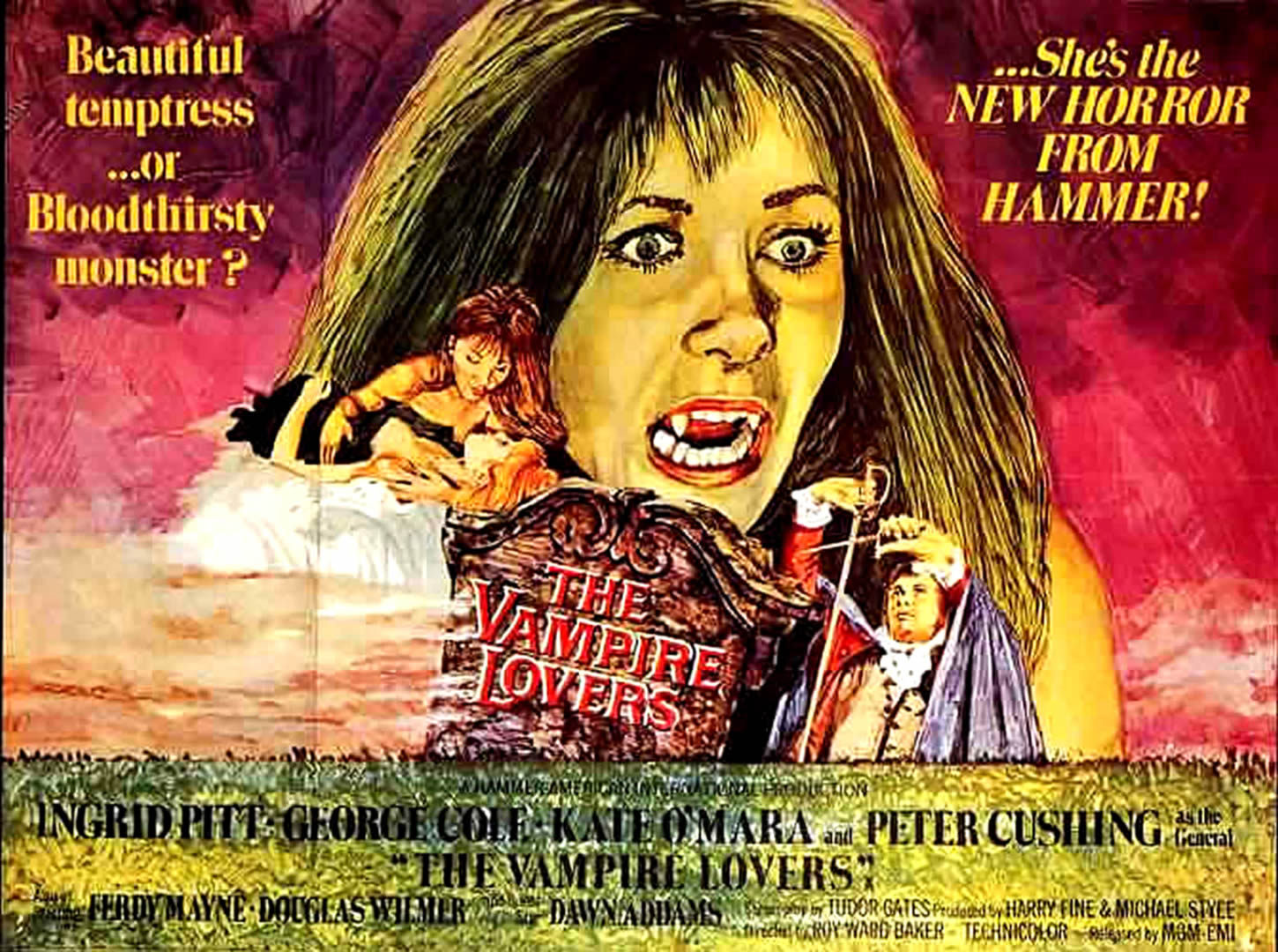
In 1971 Hammer released "Lust for a Vampire" aka: "Love for a Vampire" aka: "To Love a Vampire". In this film Danish actress Yutte Stensgaard portrays "Marcilla Herritzen" the alias of "Carmilla Karnstein".

The third film in the Trilogy, there is no continuity to any of the three films, was also from 1971 entitled "Twins of Evil". In this film German actress Katya Wyeth portrayed the "Countess Mircalla Karnstein", Note the slight change in the first name.
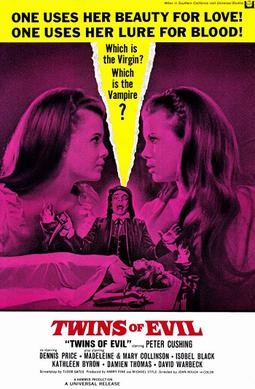
While not published until 1914. The short story by Bram Stoker "Dracula's Guest" is believed to actually be a deleted chapter from his original 1897 novel. The narrator is a man who is also believed to be "Jonathan Harker" on his way to Castle Dracula. "Dracula" is nowhere in this story.
An unnamed Englishman wanders away from an Inn near Munich on "Walpurgis Night". Actually April 30th and known as "Witches Night". He ends up at an abandoned and unholy town. There he will find a cemetery and a large marble tomb with a metal stake driven through the roof. The tomb is that of the "Countess Dolingen" and on the back in Russian is written:
If this story was actually a part of the original "Dracula" novel. It could be seen as a warning to "Harker" of what is to come, but it would also have distracted from the mystery of the "Count".
Released by Universal Studios on May 11, 1936 "Dracula's Daughter" was based upon "Dracula's Guest". However, the original short story was purchased by David O. Selznick, producer of the original 1937 "A Star was Born" and 1939's "Gone with the Wind", for MGM in 1933.
Selznick hired John L, Balderston to write the screenplay. Balderston had either written, or would write the screenplays for Universal Studio's "Frankenstein", "Dracula", based upon his own stage play, "The Mummy" and "The Bride of Frankenstein".
Balderston's screenplay for Selzick had "Van Helsing" returning to Castle Dracula to destroy the three brides in their coffins. He overlooks a fourth hidden coffin containing "Dracula's Daughter". She follows him back to London using the name of the "Countess Szekelsky". Van Helsing and the future wife of a young man the "Countess" has attacked. Will follow "Dracula's daughter" back to Transylvania and destroy the vampire.
David O' Selznick decided to sell the rights to the story to Universal Studios for a profit. He knew they wanted to make a sequel to 1931's "Dracula". Along with considering the legal issues for MGM using the name, copyrighted, by Universal.
Universal basically ignored the John L. Balderston screenplay and gave the writing job initially to R.C. Sherriff who had written the screenplay for "The Invisible Man". I really wish they had used his work. It starts in the 14th Century and looks at the Legends around Dracula. This screenplay than switches to present day and tells of two English couples visiting Transylvania. The two men explore the ruins of Castle Dracula and one goes missing and the other is found insane. Van Helsing is called in and finds the missing man a slave to the "Countess Szekelsky". Van Helsing will destroy her and save both men.
The screenplay wouldn't get past either American, or British censors. Three revised screenplays met the same fate. R,C, Sherrif was next replaced by Garrett Fort. Fort was Balderston's co-screenplay writer on both "Frankenstein" and "Dracula".His is the only credited name for the screenplay of "Dracula's Daughter". Note that the first two writers did not play the Lesbian aspect of a female vampire, but Garrett Fort used subtle sequences to make the change to the "Countess".
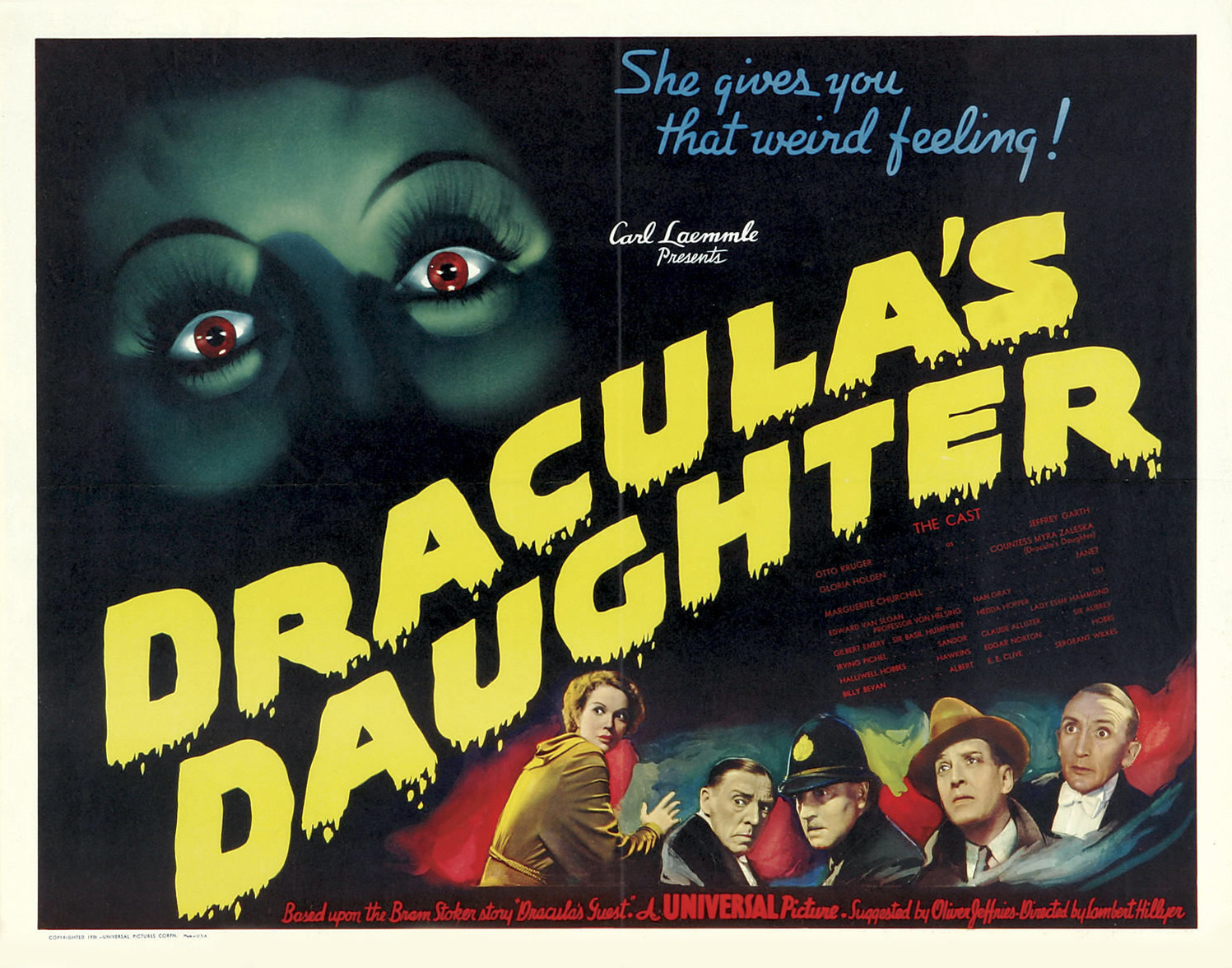
The movies Tag Line:
"CARMILLA" and 'DRACULA'S GUEST"
Bram Stoker's novel is thought by many to be the first Vampire story. This is a result of all the motion pictures made about the Transylvanian Count. In fact there were 28 other published stories, before Stoker's novel, going back to "Der Vampir" by Henrich August Ossenfelder in 1746.
I am not going back that far, but to an excellent story, "Carmilla", written by Joseph Seridan Le Fanu in 1871. Despite his French sounding name he was Irish. This excellent tale is about Lesbian Vampire "Camilla" and her love for "Laura", The story is narrated by "Laura", but is from "The Casebook of Dr. Hesselius".
According to the Doctor a coach with a mother and daughter breaks down near the home of a retired military man and his daughter. because of the time it will take to repair the coach. The mother, "Countess Karnstein", asks the father if he would take his daughter, "Carmilla", into his home. As she is the same age as his daughter, "Laura", he agrees. Thus starts the vampire tale as "Laura" begins to have strange nightmares involving her new friend.
The first film said to be a version of "Carmilla". Only faintly implies, by character, the idea of a Lesbian vampire and was a French/German production by Danish director Carl Theodor Dreyer. The 1932 motion picture was entiled "Vampyr--Der Traum des Allan Gray (Vampire--The Dream of Allan Gray)".
The story revolves around two sisters and a visitor to an inn named "Allan Gray". A series of events will follow for "Gray". It starts with a man coming into "Gray's" room to leaving a package marked not to open until after the strangers death. The two sisters are that man's daughters and, as presented in the film, seem closer to "Mina Harker" and "Lucy Westerner" in Bram Stoker's work than "Camilla" and "Laura". The vampire turns out to be an old women servant. She has been buried for years, but looks like the day she died. The fact she is a women drinking the blood of "Leone", one of the sisters, is the only really implied relationship to the specific story by Joseph Seridan Le Fanu's.
It would be another 28 years before Le Fanu's novel was actually brought to the screen by French director Roger Vadim. This is a favorite of mine. Word of warning this film was done in a French Art Style popular at the time.
Set in 1960's Italy "Et mourir de plaisir (And Die of Pleasure)" re-edited and dubbed in English by Paramount Pictures as "Blood and Roses". Tells the tale of "Georgia Monteverdi", played by Elsa Martinelli, her friend "Carmilla De Karnstein", Annette Vadim, and "Carmilla's" brother "Leopoldo De Karnstein", Mel Ferrer/
The story is changed slightly to have "Carmilla's" friend "Georgia" about to be married to her brother "Leopoldo". The last name of the family, "Karnstein", is retained and the family secret that "Carmilla" is actually a vampire or is she?
The question is the tie in to the actual Le Fanu story. The "Karnstein" family have a legendary vampire that was supposedly destroyed decades before this story. However, "Carmilla" is the exact look alike copy of her.
There is a masquerade ball, with fireworks, beautifully filmed by Vadim with vampiric symbolism.
For the masquerade "Carmilla" is wearing the same looking dress as her legendary ancestor. Earlier she had nightmares that led to the above bedroom scene. Roger Vadim used some interesting technicolor photographic imagery for her nightmare sequences.
The fireworks display sets off an old forgotten World War 2 munitions dump near the "Karnstein" cemetery. While this is occurring "Carmilla" is shown moving dreamily into the area and finding the alleged tomb of the vampire. The door to the vault slowly opens on its own and when we nest see "Carmilla" she is acting strangely.
This will lead to a series of murders and eventually "Carmilla's death". The film will end with the now married "Georgia" and "Leopoldo" on a passenger jet leaving on their honeymoon, BUT is it really "Georgia" or in a new body the legendary "Karnstein" vampire?
Annette Vadim was Rodger Vadim's second wife. His first was actress Brigitte Bardot and his third was Jane Fonda. I have written an article about the three motion pictures he made with each one. I go into more detail about "Blood and Roses" in that article. Vadim was married four times and had two domestic partners including French actress Catherine Deneuve. My article can be read at:
http://www.bewaretheblog.com/2016/08/rodger-vadim-three-wives-and-three.html
For those interested in films from "The House of Hammer". In 1970 they released the first of what would be a trilogy of films based upon Sheridan Le Fanu's story as "The Vampire Lovers". The film starred Polish born actress Ingrid Pitt as "Marcilla Karnstein". "Marcilla" will eventually use the alias of "Carmilla". The story revolves around her "love" for "Laura", Pippa Steel, the daughter of "General Spielsdrof", Peter Cushing. There are many specific scenes from the original story incorporated into the screen play.

In 1971 Hammer released "Lust for a Vampire" aka: "Love for a Vampire" aka: "To Love a Vampire". In this film Danish actress Yutte Stensgaard portrays "Marcilla Herritzen" the alias of "Carmilla Karnstein".

The third film in the Trilogy, there is no continuity to any of the three films, was also from 1971 entitled "Twins of Evil". In this film German actress Katya Wyeth portrayed the "Countess Mircalla Karnstein", Note the slight change in the first name.

While not published until 1914. The short story by Bram Stoker "Dracula's Guest" is believed to actually be a deleted chapter from his original 1897 novel. The narrator is a man who is also believed to be "Jonathan Harker" on his way to Castle Dracula. "Dracula" is nowhere in this story.
An unnamed Englishman wanders away from an Inn near Munich on "Walpurgis Night". Actually April 30th and known as "Witches Night". He ends up at an abandoned and unholy town. There he will find a cemetery and a large marble tomb with a metal stake driven through the roof. The tomb is that of the "Countess Dolingen" and on the back in Russian is written:
The Dead Travel FastThere is a storm at the time and the Englishman opens the tomb's door and sees in a flash of lighting a:
beautiful women with rounded cheeks and red lips, seemingly sleeping on a bierAs the Englishman watches in horror. Another lighting bolt strikes touches the spike and the women inside is destroyed.
If this story was actually a part of the original "Dracula" novel. It could be seen as a warning to "Harker" of what is to come, but it would also have distracted from the mystery of the "Count".
Released by Universal Studios on May 11, 1936 "Dracula's Daughter" was based upon "Dracula's Guest". However, the original short story was purchased by David O. Selznick, producer of the original 1937 "A Star was Born" and 1939's "Gone with the Wind", for MGM in 1933.
Selznick hired John L, Balderston to write the screenplay. Balderston had either written, or would write the screenplays for Universal Studio's "Frankenstein", "Dracula", based upon his own stage play, "The Mummy" and "The Bride of Frankenstein".
Balderston's screenplay for Selzick had "Van Helsing" returning to Castle Dracula to destroy the three brides in their coffins. He overlooks a fourth hidden coffin containing "Dracula's Daughter". She follows him back to London using the name of the "Countess Szekelsky". Van Helsing and the future wife of a young man the "Countess" has attacked. Will follow "Dracula's daughter" back to Transylvania and destroy the vampire.
David O' Selznick decided to sell the rights to the story to Universal Studios for a profit. He knew they wanted to make a sequel to 1931's "Dracula". Along with considering the legal issues for MGM using the name, copyrighted, by Universal.
Universal basically ignored the John L. Balderston screenplay and gave the writing job initially to R.C. Sherriff who had written the screenplay for "The Invisible Man". I really wish they had used his work. It starts in the 14th Century and looks at the Legends around Dracula. This screenplay than switches to present day and tells of two English couples visiting Transylvania. The two men explore the ruins of Castle Dracula and one goes missing and the other is found insane. Van Helsing is called in and finds the missing man a slave to the "Countess Szekelsky". Van Helsing will destroy her and save both men.
The screenplay wouldn't get past either American, or British censors. Three revised screenplays met the same fate. R,C, Sherrif was next replaced by Garrett Fort. Fort was Balderston's co-screenplay writer on both "Frankenstein" and "Dracula".His is the only credited name for the screenplay of "Dracula's Daughter". Note that the first two writers did not play the Lesbian aspect of a female vampire, but Garrett Fort used subtle sequences to make the change to the "Countess".

The movies Tag Line:
SHE GIVES YOU THAT WEIRD FEELING!Is actually perfect for Gloria Holden's understated performance as "Countess Marya Zaleska" the film's title character. Talk about perfect casting in an overlooked and somewhat forgotten motion picture.
The story starts out moments after "Professor Van Helsing" has destroyed Bela Lugosi's "Count Dracula" in the 1931 Todd Browning classic. "Van Helsing" is once more portrayed by Edward Van Sloan and two Police Officers arrest him for murder, because they see a body with a stake through the heart in a coffin and the "Professor" standing over it.
Garret Fort's screenplay has its only touch of humor in "Van Helsing's" reply to Scotland Yard. Telling them that he can't be charged with murdering a man already dead for 500 years. However, Scotland Yard thinks "Van Helsing" is totally crazy. When given the opportunity instead of getting a lawyer to defend him. He calls one of his "Star" students "Dr Jeffrey Garth", Otto Kruger. "Dr. Garth" replaces "Van Helsing" in the rest of the story.
The "Countess" and her servant "Sandor", Irving Pichel, both seen above, steal her father's body from the Scotland Yard Morgue. The two hold a ritual burning of the body in the hope that it will take the curse of vampirism off "Marya" Of course it doesn't work and she goes in search of the women of London.

"Dr. Garth attempts to help "Marya" with what he believes are delusions from mental illness.
Although some critics consider the pace of the picture slow today. One thing they all agree upon is the excellent performance Gloria Holden gave as the tortured "Countess Zaleska".
There were strong Lesbian themes connected to the "Countess". The day before director Lambert Hillyer shot a scene between "Marya" and her model "Lili", Nan Gray. Universal needed the approval of the Production Code Administration on possible censership. The head of the office, Joseph Breen, read the scene and according to Rick Worland's 2007 "The Horror Film: An Introduction" replied:
After "Dr. Garth" discovers the truth that "Marya" is a vampire. She kidnaps his girlfriend "Janet", Marguerite Churchill, to lure "Garth" to Transylvania.

There is a long scene leading up to a possible Lesbian kiss between the "Countess" and "Janet" under her spell.

The kiss never comes off as "Dr. Garth" shows up, but just the idea of the set up was shocking for 1936 audiences. To save "Janet", "Garth" offers himself to be turned into a vampire instead. The movie ends when "Sandor", after being told he will not be made immortal, shooting a wooden arrow through the heart of "Countess Marya Zaleska".
A little trivia:
Radio, stage, and film actress Jane Wyatt, a year away from director Frank Capra's classic fantasy, 1937's, "Lost Horizon", and eighteen-years away from the first episode of televisions "Father Knows Best", was originally considered for the role of "Janet Blake". Character actor Cesar Romero was three-years away from his first "Cisco Kid" movie, but not in the character, that would also be in 1939, with "The Cisco Kid and the Lady". He was originally considered for the role of "Jeffrey Garth".
As the approval of that screenplay was up against both the American and British censors as I said. Other commitments came into play. In the case of Jane Wyatt it was Frank Capra's version of James Hilton's novel "Lost Horizon" starring Ronald Coleman.. Bela Lugosi went to MGM and made Todd Browning's "Mark of the Vampire".
Another name related to this version of "Dracula's Daughter" was James Whale as director. However, he wouldn't commit until he filmed the musical "Showboat" and was dropped.
Garret Fort's screenplay has its only touch of humor in "Van Helsing's" reply to Scotland Yard. Telling them that he can't be charged with murdering a man already dead for 500 years. However, Scotland Yard thinks "Van Helsing" is totally crazy. When given the opportunity instead of getting a lawyer to defend him. He calls one of his "Star" students "Dr Jeffrey Garth", Otto Kruger. "Dr. Garth" replaces "Van Helsing" in the rest of the story.
The "Countess" and her servant "Sandor", Irving Pichel, both seen above, steal her father's body from the Scotland Yard Morgue. The two hold a ritual burning of the body in the hope that it will take the curse of vampirism off "Marya" Of course it doesn't work and she goes in search of the women of London.

"Dr. Garth attempts to help "Marya" with what he believes are delusions from mental illness.
Although some critics consider the pace of the picture slow today. One thing they all agree upon is the excellent performance Gloria Holden gave as the tortured "Countess Zaleska".
There were strong Lesbian themes connected to the "Countess". The day before director Lambert Hillyer shot a scene between "Marya" and her model "Lili", Nan Gray. Universal needed the approval of the Production Code Administration on possible censership. The head of the office, Joseph Breen, read the scene and according to Rick Worland's 2007 "The Horror Film: An Introduction" replied:
The present suggestion that...Lili poses in the nude will be changed. She will be posing her neck and shoulders, and there will be no suggestion that she undresses, and there will be no exposure of her person. It was also stated that the present incomplete sequence will be followed by a scene in which Lili is taken to a hospital and there it will be definitely established that she has been attacked by a vampire. The whole sequence will be treated in such a way as to avoid any suggestion of perverse sexual desire on the part of Marya or of an attempted sexual attack by her upon Lili.
After "Dr. Garth" discovers the truth that "Marya" is a vampire. She kidnaps his girlfriend "Janet", Marguerite Churchill, to lure "Garth" to Transylvania.
There is a long scene leading up to a possible Lesbian kiss between the "Countess" and "Janet" under her spell.

The kiss never comes off as "Dr. Garth" shows up, but just the idea of the set up was shocking for 1936 audiences. To save "Janet", "Garth" offers himself to be turned into a vampire instead. The movie ends when "Sandor", after being told he will not be made immortal, shooting a wooden arrow through the heart of "Countess Marya Zaleska".
A little trivia:
Radio, stage, and film actress Jane Wyatt, a year away from director Frank Capra's classic fantasy, 1937's, "Lost Horizon", and eighteen-years away from the first episode of televisions "Father Knows Best", was originally considered for the role of "Janet Blake". Character actor Cesar Romero was three-years away from his first "Cisco Kid" movie, but not in the character, that would also be in 1939, with "The Cisco Kid and the Lady". He was originally considered for the role of "Jeffrey Garth".
As the approval of that screenplay was up against both the American and British censors as I said. Other commitments came into play. In the case of Jane Wyatt it was Frank Capra's version of James Hilton's novel "Lost Horizon" starring Ronald Coleman.. Bela Lugosi went to MGM and made Todd Browning's "Mark of the Vampire".
Another name related to this version of "Dracula's Daughter" was James Whale as director. However, he wouldn't commit until he filmed the musical "Showboat" and was dropped.
"THE VAMPIRE'S GHOST"
On May 27, 1945 Republic Pictures released "The Vampire's Ghost". Although John K. Butler has the main screenplay writing credit. It is acknowledged this was really Leigh Brackett's first screenplay and Butler only reviewed her writing. Leigh Brackett would be known to fans of excellent 1950's science fiction as "The Queen of the Space Opera".
This original vampire tale was all Brackett and she does get that additional on screen credit.
My article on the original writer of "Star Wars: The Empire Strikes Back", "LEIGH BRACKETT: Howard Hawks and John Wayne Meet 'The Queen of Space Opera", may be read at:
http://www.bewaretheblog.com/2018/06/leigh-brackett-john-wayne-meets-queen.html
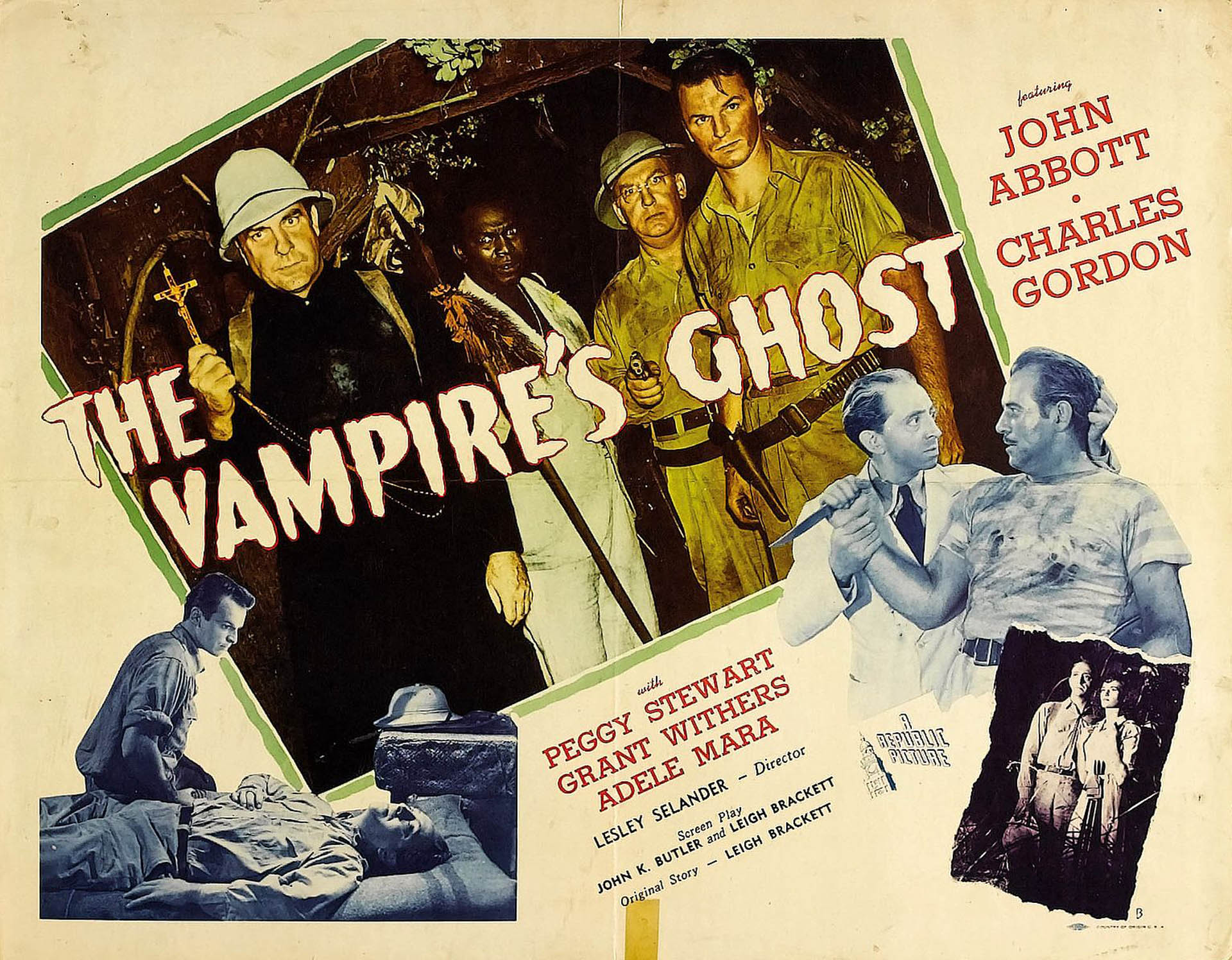
The best way, in my opinion, to describe "The Vampire's Ghost" is "Dracula Meets Casablanca"/ Although "Webb Fallon" is in no way like Bram Stoker's famous vampire.
Describing how she was offered this writing job. Scott Myers on November 25, 2015 in his "How to Write a Script" series quoted Leigh Brackett on Republic:
The story is set in the African town of Bakunda and revolves around a local bar and nightclub owned by "Webb Fallon" portrayed by John Abbott. Abbott's performance, like many of his others, is very low keyed. His vampire is never over the top as Bela Lugosi was in 1931's "Dracula", 1935's "Mark of the Vampire" and 1944's "Return of the Vampire", or even how John Carradine's performance was in 1944's "House of Frankenstein". Leigh Brackett's "Fallon" is a very likable person and he can walk around in direct sunlight. The only notable difference, from other white residents of the town, is he wears very dark sun glasses.
.jpg)
British actor Abbott had been in motion picture starting in the U.K. before World War 2. Some of his appearances included portraying "Prospero" in 1939, This was in a two part version for British television of William Shakespeare's "The Tempest" and yes there was television in 1939. That same year he appeared in "The Saint in London" starring George Sanders. In 1942 Abbott appeared in the American made "Mrs. Miniver" starring Greer Garson and Walter Pidgeon set in England.
Over his 164 roles John Abbott's films had a wide range. They included 1943's propaganda war movie "The Cross of Lorraine" starring Gene Kelly, 1944's "Cry of the Werewolf", 1946's "The Bandit of Sherwood Forest" playing "Will Scarlet" and the 1958 musical "Gigi" staring Leslie Caron and Louis Jourdon.
_007.jpg)
Above Peggy Stewart as "Julie Vance" and Charles Gordon as "Roy Henrick".
Peggy Stewart started her career at Paramount Pictures in 1937's "Wells Fargo" playing Joel McCrea's teenage daughter. She moved to Republic and starting in 1944 portrayed the role of the "Girl in Distress" in many of "B" Westens featuring Allan Lane, "Sunset" Carson and "Wild Bill" Elliot. This film was a break for her. While Charles Gordon has a total of nine acting credits to his name and this was number four.
"Roy Henrick" returns home to the town of Bakunda to discover the small community is frightened, because of a series of murders. Each victim has been drained of blood and there are two tiny puncture marks on their necks.The natives claim it is a vampire. Sounds liked a typical vampire movie, but the audience is dealing with Leigh Douglas Brackett.
The local nightclub is run by newcomer "Webb Fallon" For the small community on the Ivory Coast this is the place to gather and enjoy entertainment. Think of it as "Rick's Place Meets Tarzan" with a vampire "host" that like any of his "guests", smokes.
First by being thrown out of the nightclub by an extremely strong "Fallon" and second by becoming a victim of the vampire.
.jpg)
.jpg)
Then it's "Webb Fallon's" dancer "Lisa", Adele Mara, who makes a mistake and is killed by the vampire.
"Roy", his girl friend "Julie", and her father "Thomas Vance", Emmett Vogan, the owner of a large plantation, decide to speak to "Webb". Apparently he is an expert on the occult and voodoo. He should be as he's been around for 400 years. Another twist on Stoker and other vampire story writers is that in a box presented to him by "Queen Elizabeth the First". "Fallon" keeps some of his original burial soil. At night he sleeps not in a coffin, but a normal bed. The box is kept under the pillow where his head rests. Webb Fallon" was actually one of the Sea Captain's of Elizabeth's fleet that fought the Spanish Armada in 1588.
.jpg)
A native discovers the truth about "Webb" as they are talking. This happens when he notices that "Fallon" is not casting a reflection in a mirror. An attempt to kill him with a silver tip spear fails initially.
.jpg)
.jpg)
"Roy" has also become suspicious of "Fallon". He finds the vampire with the spear head in him and "Webb" convinces "Roy" to remove it. Bad move on "Henrick's" part.
.jpg)
The vampire reveals his whole history to "Roy", but then puts him under a curse. Turning "Roy" into part Zombie and his slave. When "Roy" goes back to "Julie" and her father. He appears normal, but also feverish.

After realizing that everyone knows the truth. "Fallon" places "Julie" under a voodoo spell and has her come to him. Leigh Brackett is deftly mixing African Voodoo with European Vampire Legends.
.jpg)
.jpg)

Below it is up to "Father Gilchrist", Grant Withers, to break the hold "Webb Fallon" has on "Roy Henrick's". Then they go after the vampire as the local natives already are doing.
Wither's name may not be familiar to my reader, but he appeared as "Police Captain William 'Bill' Street" in five of the "Mr. Wong Detective" films starring Boris Karloff,. He was "Ike Clanton" in John Ford's 1946 "Mr. Darling Clementine", the villain "Silas Meacham" in Ford's 1948 "Fort Apache" and the Deputy Marshall in Ford's 1950's "Rio Grande".

That film's climax comes at the ruins of an old Temple deep within the African Jungle. It is here that "Fallon's" actual coffin is hidden.
.jpg)
|


_034.jpg)
The movie is now available on Blu-ray and is worth a look. This feature is part of five forgotten little thriller gems from the 1940's I wrote about at:
http://www.bewaretheblog.com/2016/11/the-undying-monster-seventh-victim.html
'CAPTAIN KRONOS" and "LIFEFORCE'
When we think of vampires. It is as a creature who sucks the blood out of a person and those two tiny teeth punctures on their neck. The next two motion pictures took different looks on what the vampire was after.
On April 7, 1974 Hammer films released "Captain Kronos: Vampire Hunter" written and directed by Brian Clemens. Clemens wrote the original script for the BBC's popular "The Avengers" television series and remained both the script editor and an associate producer on the entire run of the series. In "Captain Kronos" Clemens did an original twist on the typical vampire tale.
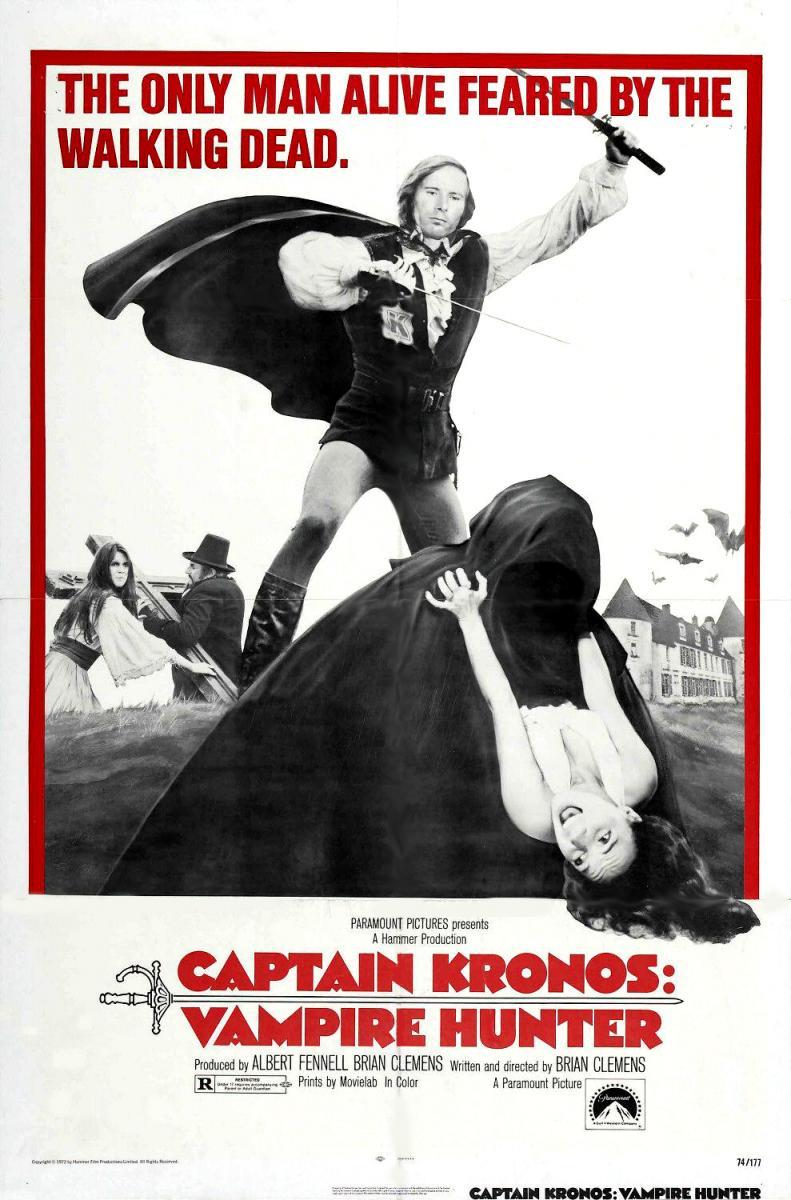
The motion picture was planned as the first of a series about "Kronos" and his friends, but that never materialized. When it was released in the United States it received an "R" rating.
A village is plagued by mysterious deaths and "Dr. Marcus", John Carson, calls on his old friend "Captain Kronos", Horst Janson. The vampire hunter is accompanied by a hunchback named "Professor Hieronymus Grost", John Carter.

After examining one of the bodies "Professor Grost" explains to "Marcus" that this girl died from a vampire, but not the type that drinks blood. These vampires are a variation of the ones of myth and legend. They feed on youth.


Enter Caroline Munro, "Carla", a local Gypsy girl who becomes an ally of "Kronos" and "Grost". As they track down the vampires.
"Dr. Marcus" has become a vampire and begs "Kronos" to kill him. The vampire hunter attempts to kill "Marcus" with a wooden stake, but this fails as does some other known ways. During all of these attempts "Kronos" accidentally pierces the doctor's heart with a steel cross the doctor has been wearing around his neck destroying the vampire. The means of destroying the creatures behind the plague has been discovered.
All clues lead to the children of the "Lady Durward", Wanda Ventham. They are her son "Paul", Shane Briant, and daughter "Sara", Lois Daine. The plan is to have "Carla" seek help from the bedridden "Lady Durward". This is accomplished, but then it turns out that "Lady Durward" is actually the original vampire seeking eternal youth.
"Captain Kronos" will use a newly created mirrored sword that will blind the Youth Draining Vampires and enable him to kill them with steel.




This is an excellent movie and based upon the initial response Hammer Films issued a three part comic book adaption in 1976 and a novelization. I could not locate the reason for not making a sequel.
This original vampire tale was all Brackett and she does get that additional on screen credit.
My article on the original writer of "Star Wars: The Empire Strikes Back", "LEIGH BRACKETT: Howard Hawks and John Wayne Meet 'The Queen of Space Opera", may be read at:
http://www.bewaretheblog.com/2018/06/leigh-brackett-john-wayne-meets-queen.html

The best way, in my opinion, to describe "The Vampire's Ghost" is "Dracula Meets Casablanca"/ Although "Webb Fallon" is in no way like Bram Stoker's famous vampire.
Describing how she was offered this writing job. Scott Myers on November 25, 2015 in his "How to Write a Script" series quoted Leigh Brackett on Republic:
they were doing this horror film. They decided to cash in on the Universal monster school, and I had been doing science fiction, and to them it all looked the same — “bug-eyed monsters.It made no difference.Another interview from 1975 first published in 1976 can be found on the website "Tangent" In it. Leigh described the shooting schedule on her first motion picture:
They shot the film in ten days and that was two days over schedule (laughing). They fired the cameraman after the second day because he was taking too much time. But uh, it was not the greatest film ever made.https://www.tangentonline.com/interviews-columnsmenu-166/1270-classic-leigh-brackett-a-edmond-hamilton-interview
The story is set in the African town of Bakunda and revolves around a local bar and nightclub owned by "Webb Fallon" portrayed by John Abbott. Abbott's performance, like many of his others, is very low keyed. His vampire is never over the top as Bela Lugosi was in 1931's "Dracula", 1935's "Mark of the Vampire" and 1944's "Return of the Vampire", or even how John Carradine's performance was in 1944's "House of Frankenstein". Leigh Brackett's "Fallon" is a very likable person and he can walk around in direct sunlight. The only notable difference, from other white residents of the town, is he wears very dark sun glasses.
.jpg)
British actor Abbott had been in motion picture starting in the U.K. before World War 2. Some of his appearances included portraying "Prospero" in 1939, This was in a two part version for British television of William Shakespeare's "The Tempest" and yes there was television in 1939. That same year he appeared in "The Saint in London" starring George Sanders. In 1942 Abbott appeared in the American made "Mrs. Miniver" starring Greer Garson and Walter Pidgeon set in England.
Over his 164 roles John Abbott's films had a wide range. They included 1943's propaganda war movie "The Cross of Lorraine" starring Gene Kelly, 1944's "Cry of the Werewolf", 1946's "The Bandit of Sherwood Forest" playing "Will Scarlet" and the 1958 musical "Gigi" staring Leslie Caron and Louis Jourdon.
_007.jpg)
Above Peggy Stewart as "Julie Vance" and Charles Gordon as "Roy Henrick".
Peggy Stewart started her career at Paramount Pictures in 1937's "Wells Fargo" playing Joel McCrea's teenage daughter. She moved to Republic and starting in 1944 portrayed the role of the "Girl in Distress" in many of "B" Westens featuring Allan Lane, "Sunset" Carson and "Wild Bill" Elliot. This film was a break for her. While Charles Gordon has a total of nine acting credits to his name and this was number four.
"Roy Henrick" returns home to the town of Bakunda to discover the small community is frightened, because of a series of murders. Each victim has been drained of blood and there are two tiny puncture marks on their necks.The natives claim it is a vampire. Sounds liked a typical vampire movie, but the audience is dealing with Leigh Douglas Brackett.
The local nightclub is run by newcomer "Webb Fallon" For the small community on the Ivory Coast this is the place to gather and enjoy entertainment. Think of it as "Rick's Place Meets Tarzan" with a vampire "host" that like any of his "guests", smokes.
First by being thrown out of the nightclub by an extremely strong "Fallon" and second by becoming a victim of the vampire.
.jpg)
.jpg)
Then it's "Webb Fallon's" dancer "Lisa", Adele Mara, who makes a mistake and is killed by the vampire.
"Roy", his girl friend "Julie", and her father "Thomas Vance", Emmett Vogan, the owner of a large plantation, decide to speak to "Webb". Apparently he is an expert on the occult and voodoo. He should be as he's been around for 400 years. Another twist on Stoker and other vampire story writers is that in a box presented to him by "Queen Elizabeth the First". "Fallon" keeps some of his original burial soil. At night he sleeps not in a coffin, but a normal bed. The box is kept under the pillow where his head rests. Webb Fallon" was actually one of the Sea Captain's of Elizabeth's fleet that fought the Spanish Armada in 1588.
.jpg)
A native discovers the truth about "Webb" as they are talking. This happens when he notices that "Fallon" is not casting a reflection in a mirror. An attempt to kill him with a silver tip spear fails initially.
.jpg)
.jpg)
"Roy" has also become suspicious of "Fallon". He finds the vampire with the spear head in him and "Webb" convinces "Roy" to remove it. Bad move on "Henrick's" part.
.jpg)
The vampire reveals his whole history to "Roy", but then puts him under a curse. Turning "Roy" into part Zombie and his slave. When "Roy" goes back to "Julie" and her father. He appears normal, but also feverish.

After realizing that everyone knows the truth. "Fallon" places "Julie" under a voodoo spell and has her come to him. Leigh Brackett is deftly mixing African Voodoo with European Vampire Legends.
.jpg)
.jpg)

Below it is up to "Father Gilchrist", Grant Withers, to break the hold "Webb Fallon" has on "Roy Henrick's". Then they go after the vampire as the local natives already are doing.
Wither's name may not be familiar to my reader, but he appeared as "Police Captain William 'Bill' Street" in five of the "Mr. Wong Detective" films starring Boris Karloff,. He was "Ike Clanton" in John Ford's 1946 "Mr. Darling Clementine", the villain "Silas Meacham" in Ford's 1948 "Fort Apache" and the Deputy Marshall in Ford's 1950's "Rio Grande".

That film's climax comes at the ruins of an old Temple deep within the African Jungle. It is here that "Fallon's" actual coffin is hidden.
.jpg)
|


_034.jpg)
The movie is now available on Blu-ray and is worth a look. This feature is part of five forgotten little thriller gems from the 1940's I wrote about at:
http://www.bewaretheblog.com/2016/11/the-undying-monster-seventh-victim.html
'CAPTAIN KRONOS" and "LIFEFORCE'
When we think of vampires. It is as a creature who sucks the blood out of a person and those two tiny teeth punctures on their neck. The next two motion pictures took different looks on what the vampire was after.
On April 7, 1974 Hammer films released "Captain Kronos: Vampire Hunter" written and directed by Brian Clemens. Clemens wrote the original script for the BBC's popular "The Avengers" television series and remained both the script editor and an associate producer on the entire run of the series. In "Captain Kronos" Clemens did an original twist on the typical vampire tale.

The motion picture was planned as the first of a series about "Kronos" and his friends, but that never materialized. When it was released in the United States it received an "R" rating.
A village is plagued by mysterious deaths and "Dr. Marcus", John Carson, calls on his old friend "Captain Kronos", Horst Janson. The vampire hunter is accompanied by a hunchback named "Professor Hieronymus Grost", John Carter.

After examining one of the bodies "Professor Grost" explains to "Marcus" that this girl died from a vampire, but not the type that drinks blood. These vampires are a variation of the ones of myth and legend. They feed on youth.


Enter Caroline Munro, "Carla", a local Gypsy girl who becomes an ally of "Kronos" and "Grost". As they track down the vampires.
"Dr. Marcus" has become a vampire and begs "Kronos" to kill him. The vampire hunter attempts to kill "Marcus" with a wooden stake, but this fails as does some other known ways. During all of these attempts "Kronos" accidentally pierces the doctor's heart with a steel cross the doctor has been wearing around his neck destroying the vampire. The means of destroying the creatures behind the plague has been discovered.
All clues lead to the children of the "Lady Durward", Wanda Ventham. They are her son "Paul", Shane Briant, and daughter "Sara", Lois Daine. The plan is to have "Carla" seek help from the bedridden "Lady Durward". This is accomplished, but then it turns out that "Lady Durward" is actually the original vampire seeking eternal youth.
"Captain Kronos" will use a newly created mirrored sword that will blind the Youth Draining Vampires and enable him to kill them with steel.




This is an excellent movie and based upon the initial response Hammer Films issued a three part comic book adaption in 1976 and a novelization. I could not locate the reason for not making a sequel.
On February 10, 1957, Roger Corman released the original "Not of this Earth". Beverly Garland plays a nurse taking care of a millionaire with a rare blood disease. In actuality, Paul Birch is an Intergalactic vampire collecting samples for a possible invasion of Earth. The movie is down right scary and Birch will give you nightmares. When he takes off his ray-bans he burns your brain to a crisp through your eyes.
Based partly upon British author Colin Wilson's 1976 science fiction novel "The Space Vampires" was an American/British feature film directed by Toby Hooper. 1985's "Lifeforce" tells of the discovery of a 150 mile long spacecraft hidden in the tail of Haley's comet.
Upon entering the craft the crew of the space shuttle "Churchill" discover three naked bodies. Two are men on each side of a women and all are in glass containers. What the crew of the space shuttle lead by "Colonel Tom Carlsen", Steve Railsback, do not realize is that the three are really in a state of suspended animation and the women is telepathic. She has changed the three's real form to reflect human beings.
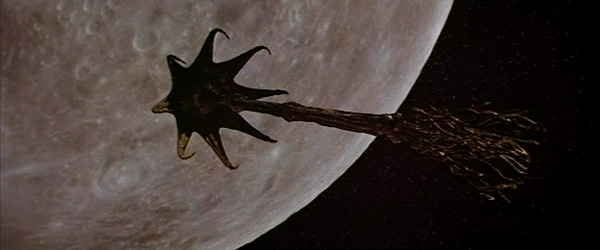

Mistake #1:The crew brings the three on board the "Churchill" and things start to happen. Contact is lost with the shuttle and a rescue mission is sent. They discover that a fire had broken out and the crew apparently were burned alive. Mistake #2: Upon orders the rescue shuttle take the three aliens back to Earth.
Prior to an autopsy on the alien bodies the women, French actress Mathilda May, awakens and drains the "Lifeforce" out of one of the military guards.
Upon entering the craft the crew of the space shuttle "Churchill" discover three naked bodies. Two are men on each side of a women and all are in glass containers. What the crew of the space shuttle lead by "Colonel Tom Carlsen", Steve Railsback, do not realize is that the three are really in a state of suspended animation and the women is telepathic. She has changed the three's real form to reflect human beings.


Mistake #1:The crew brings the three on board the "Churchill" and things start to happen. Contact is lost with the shuttle and a rescue mission is sent. They discover that a fire had broken out and the crew apparently were burned alive. Mistake #2: Upon orders the rescue shuttle take the three aliens back to Earth.
Prior to an autopsy on the alien bodies the women, French actress Mathilda May, awakens and drains the "Lifeforce" out of one of the military guards.
Then totally naked she walks out of the European Research Center in London. This is followed by the body of the guard coming to life and seeking the "Lifeforce" of another person. Who in turn will seek out another person, etc. etc.

The scientists realize that the three are actually "Space Vampires" that feed off the energy of other species rather than drinking blood. I often wondered if writer Colin Wilson might not have seen "Captain Kronos: Vampire Hunter" from two years prior to his science fiction novel's publican?
While this is all transpiring two other events occur. In Texas the escape pod from the "Churchill" is found with "Colonel Carlsen" inside. He is flown to London where he describes the events around the discovery of the space craft and what happened to the "Churchill". The second event is the discovery that the female space vampire can both shape-shift, or take over the living body of anyone she chooses to communicate with the humans. What is unknown at the time is that she is actually in love with "Carlsen" and wants him for her new mate.
This all leads to a great performance by Patrick Stewart as "Dr, Armstong" possessed by the female alien and acting effeminate. Below, "Special Air Service Colonel Colin Crane", Peter Firth, restrains Patrick Stewart and then Steve Railsback speaks to the alien through Stewart.
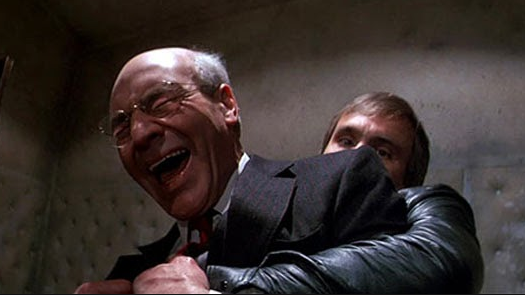
.
Things have gotten out of control and London is quarantined. As the population is being totally converted into vampires. The following picture shows one of the male space vampires being destroyed in what may, or may not be their true form. Very symbolic of the vampires of Earth legend. A theme brought up by one of the scientists.

In the end "Colonel Tom Carlsen" gives in to his desire for the female alien.

And as London is in total chaos the audience sees the two ascend on a beam of light to the alien spacecraft. The craft resumes its flight in the tail of Haley's Comet with both in glass coffins.
Initially director Toby Hooper planned to remake 1967's "Five Million Years to Earth". That was the title of Hammer films version of the third episode of the BBC series about "Professor Bernard Quatermass".The UK title for that picture was also the title of the BBC mini-series "Quartermass and the Pit".
As Toby Hooper said in an 2013 interview for the DVD release:
Should my reader be interested I did a four part look at "The House of Hammer". The first one deals with my favorite character and that is "Bernard Quatermass". The second is a look at the works of director Terrace Fisher. The third is about character actor Michael Ripper. You may not know the name, but if you're familiar with the 1950's and 1960's Hammer films you know his face. The fourth part is about make-up artist Philip Leakey
Here is a link to this article:
http://www.bewaretheblog.com/2015/02/hammer-films-look-at-house-of-hammer.html
"ATOM AGE VAMPIRE" and "PLANET OF THE VAMPIRES"
Two points to begin with:
Both motion pictures were made in Italy in Italian.
Both movies have nothing to do with vampires.

The actual Italian title of this 1960 motion picture was "Seddok, l'erede di Satana (Atom Age, the Heir of Satan). When this picture was dubbed into English and released by "Topaz Films" in the United States. The title become "Atom Age Vampire". I explain that change in moment.
Another point about this picture, which sources still incorrectly state, is that the film was made by Italian director Mario Bava. This is false, but the mistake is an easy one to understand. The actual producer/director is Elio Ippolito Melina. He used the on screen name of Mario Fava. One letter change and a neat trick to attract audiences in Italy.
Speaking of Mario Bava. He directed a great horror film that does have both witches and vampires in it. The title in Italian was "La maschera del demonio (The Demon's Mask)", but was known in English as "The Mask of Satan". This motion picture, like the one I am discussing, was also released in this country in 1960.
America in 1960 was still feeling the power of "The House Committee on Un-American Activities". The powerful motion picture industry was scared to use the word "Satan" in either a title, or in dialogue. So Mario Bava's picture took on the strange title of "Black Sunday". While "Atom Age, the Heir of Satan", which has a symbolic title, became "Atom Age Vampire" without a real vampire being seen.
That feature's basic plot has a brilliant scientist/surgeon wanting to restore the disfigured face of a women who survived a car accident. He succeeds, but it is only temporary and as he has fallen in love with her. He will kill as many women as needed for their glands to make his special formula. This leaves a hole in their neck were the glands are extracted and, hence, the idea of a vampire comes from.
So that he will have no remorse over the murders he needs to commit. The doctor injects himself with another formula turning him into the title character. A weird dialogue aspect to this film happens with Japanese dock workers at the scene of one of the murders. They tell the police that they call this killer "Seddok". Which although is not a Japanese word is suppose to be a Japanese name.
Once more I bring up the name of Mario Bavo as director of the second motion picture I want to mention. "Terrore nello spazio (Terror in Space)" was released in Italy on September 15, 1965.

The scientists realize that the three are actually "Space Vampires" that feed off the energy of other species rather than drinking blood. I often wondered if writer Colin Wilson might not have seen "Captain Kronos: Vampire Hunter" from two years prior to his science fiction novel's publican?
While this is all transpiring two other events occur. In Texas the escape pod from the "Churchill" is found with "Colonel Carlsen" inside. He is flown to London where he describes the events around the discovery of the space craft and what happened to the "Churchill". The second event is the discovery that the female space vampire can both shape-shift, or take over the living body of anyone she chooses to communicate with the humans. What is unknown at the time is that she is actually in love with "Carlsen" and wants him for her new mate.
This all leads to a great performance by Patrick Stewart as "Dr, Armstong" possessed by the female alien and acting effeminate. Below, "Special Air Service Colonel Colin Crane", Peter Firth, restrains Patrick Stewart and then Steve Railsback speaks to the alien through Stewart.

.

Things have gotten out of control and London is quarantined. As the population is being totally converted into vampires. The following picture shows one of the male space vampires being destroyed in what may, or may not be their true form. Very symbolic of the vampires of Earth legend. A theme brought up by one of the scientists.

In the end "Colonel Tom Carlsen" gives in to his desire for the female alien.

And as London is in total chaos the audience sees the two ascend on a beam of light to the alien spacecraft. The craft resumes its flight in the tail of Haley's Comet with both in glass coffins.
Initially director Toby Hooper planned to remake 1967's "Five Million Years to Earth". That was the title of Hammer films version of the third episode of the BBC series about "Professor Bernard Quatermass".The UK title for that picture was also the title of the BBC mini-series "Quartermass and the Pit".
As Toby Hooper said in an 2013 interview for the DVD release:
I thought I'd go back to my roots and make a 70 mm Hammer film.Although he was handed the Colin Wilson novel "The Space Vampires". Anyone familiar with the 1967 Hammer Production will notice a lot of plot elements and several sequences recreated by Hopper for "Lifeforce".
Should my reader be interested I did a four part look at "The House of Hammer". The first one deals with my favorite character and that is "Bernard Quatermass". The second is a look at the works of director Terrace Fisher. The third is about character actor Michael Ripper. You may not know the name, but if you're familiar with the 1950's and 1960's Hammer films you know his face. The fourth part is about make-up artist Philip Leakey
Here is a link to this article:
http://www.bewaretheblog.com/2015/02/hammer-films-look-at-house-of-hammer.html
"ATOM AGE VAMPIRE" and "PLANET OF THE VAMPIRES"
Two points to begin with:
Both motion pictures were made in Italy in Italian.
Both movies have nothing to do with vampires.

The actual Italian title of this 1960 motion picture was "Seddok, l'erede di Satana (Atom Age, the Heir of Satan). When this picture was dubbed into English and released by "Topaz Films" in the United States. The title become "Atom Age Vampire". I explain that change in moment.
Another point about this picture, which sources still incorrectly state, is that the film was made by Italian director Mario Bava. This is false, but the mistake is an easy one to understand. The actual producer/director is Elio Ippolito Melina. He used the on screen name of Mario Fava. One letter change and a neat trick to attract audiences in Italy.
Speaking of Mario Bava. He directed a great horror film that does have both witches and vampires in it. The title in Italian was "La maschera del demonio (The Demon's Mask)", but was known in English as "The Mask of Satan". This motion picture, like the one I am discussing, was also released in this country in 1960.
America in 1960 was still feeling the power of "The House Committee on Un-American Activities". The powerful motion picture industry was scared to use the word "Satan" in either a title, or in dialogue. So Mario Bava's picture took on the strange title of "Black Sunday". While "Atom Age, the Heir of Satan", which has a symbolic title, became "Atom Age Vampire" without a real vampire being seen.
That feature's basic plot has a brilliant scientist/surgeon wanting to restore the disfigured face of a women who survived a car accident. He succeeds, but it is only temporary and as he has fallen in love with her. He will kill as many women as needed for their glands to make his special formula. This leaves a hole in their neck were the glands are extracted and, hence, the idea of a vampire comes from.
So that he will have no remorse over the murders he needs to commit. The doctor injects himself with another formula turning him into the title character. A weird dialogue aspect to this film happens with Japanese dock workers at the scene of one of the murders. They tell the police that they call this killer "Seddok". Which although is not a Japanese word is suppose to be a Japanese name.
Once more I bring up the name of Mario Bavo as director of the second motion picture I want to mention. "Terrore nello spazio (Terror in Space)" was released in Italy on September 15, 1965.
When it came to the United States the following month it was in a United States version now
titled "Planet of the Vampires".
The American screenplay was rewritten by Ib Melchior. Melchoir had created both "The Angry Red Planet" and "Reptilicus", both versions, and was an accomplished screenplay writer since early science fiction television. His bio can be found on my blog at:
http://www.bewaretheblog.com/2016/06/ib-mechior-from-world-war-2-office-of.html
Two huge interplanetary space ships receive a distress signal from an unknown plant. It is decided to land there. Bad mistake and does this sound familiar?
One of the two space craft crush lands and the second ship's crew searches for them. The crew of the first craft are all dead apparently having killed each other. Why? The second crew bury them and starts a search of the area for the source of the distress call.
They discover many other crashed space craft that have answered the distress call. One has giant alien skeletons. Remind you of another movie with a similar scene?

There are no vampires as I said in this film, but the dying planet is inhabited by the "Auran's". This is their planet and the race of pure thought beings need bodies to escape to a fertile world. They possess the dead and buried crew members to enable them to take over the second space craft. So if you want to equate "possession" with "vampirism". They I guess Melchior's title works, but there is no reference to the word vampire in the script.
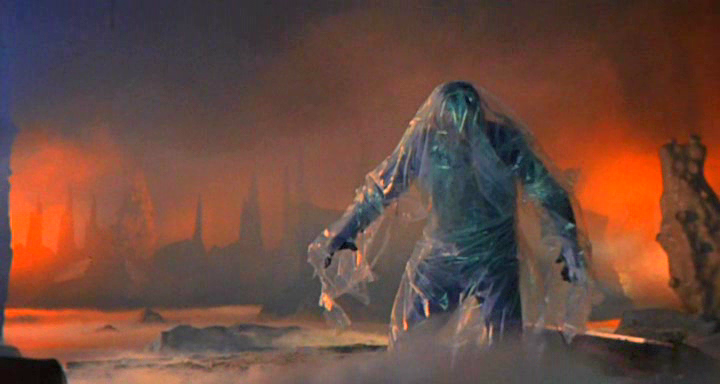
The film ends with the two leading actors Barry Sullivan as "Captain Mark Markary" and Norma Bengell as "Sanya" heading for Earth possessed by the "Auran's".

My article on Mario Bava and Dario Argento can be found at the following link. In that article I go into detail about this motion picture's influences upon Ridley Scott's "Alien".
http://www.bewaretheblog.com/2015/07/dario-argento-and-mario-bava-two.html
'THE VAMPIRE" and "BLOOD OF DRACULA"
Back in the mid-1950's, because of the power of that new medium television. Which was keeping adults in front of now affordable television sets. Many motion picture companies aimed their films at teens, pre-teens and the Drive-in movie crowd, because they could get the price of a ticket from their parents. This is a look at two of these "Teen" films of that period. For a look at others such as "Steven" McQueen in "The Blob" and Robert Vaughn in "Teenage Cave Man". Which he claimed never to have made. My article on the teen monster craze can be found at:
http://www.bewaretheblog.com/2016/06/i-was-teenage-werewolf-i-was-teenage.html
I was still 10 years old when the movie "The Vampire" was released on June 14, 1957. The working title for the film was "It's Always Darkest Before the Dawn" and when it first came on television the title was charged to "Mark of the Vampire". Which caused confusion with the previously mentioned 1935 Todd Browning feature.

According to the magazine "Fangora" this picture was:
one of the best independent horror films of the 1950'sThe review of the movie on "Turner Classic Movies" stated:
Unfairly lumped with other grade-B horror flicks from its era, The Vampire (1957) actually deserves some credit for adding a new spin - pill addiction - to this overexposed horror genre and placing the story in a contemporary settingThe screenplay was by Pat Fielder a name not known by most. Pat wrote the excellent screenplay for "The Monster the Challenged the World" also released in 1957. Most of Fielder's work would be in television.
Then there was the cast:
John Beal starred as "Dr. Paul Beecher". Beal had been in movies since 1933. In 1935 he played "Marius" is the classic screen version of "Les Miserables" starring Frederick March and Charles Laughton, in 1939 he was third billed after Bob Hope and Paulette Goddard in the horror/mystery "The Cat and the Canary". In 1960 John Beal would portray John Wesley Powell, the first man to map the entire Colorado River, in Walt Disney's "Ten Who Dared".
Collen Gray co-starred as "Carol Butler". The actress was fifth billed in Howard Hawks' "Red River", She was "The Leech Woman" and appeared in "The Phantom Planet", Like many actors of the period Gray made many television appearances through 1985.
Kenneth Tobey portrayed "Sheriff Buck Donnelly". My ex-neighbor at the time would always be known for "The Thing from Another World", "The Beast from 20,000 Fathoms" and "It, Came from Beneath the Sea". My childhood memory of Tobey can be read at:
http://www.bewaretheblog.com/2016/10/a-memory-of-my-neighbors-barbara-luddy.html
The plot of "The Vampire" is very simple, but reflected America's Cold War concerns and fears with science. "Dr. Campbell" has been experimenting with vampire bat blood. The doctor has a heart attack and "Dr. Beecher" is called in to examine the body. Among "Dr. Campbell's" effects is a bottle containing a pill form of vampire bat blood, Absentmindedly the kindly "Dr. Beecher" puts the bottle in his coat pocket.
Back at the office "Beecher" checks with his receptionist/nurse/would love to be wife "Carol". The widower's daughter "Betsy", Lydia Reed, comes in and he asks her to get his migraine pills from his coat. The audience knows what's coming next as she gets the wrong bottle and "Dr Beecher" takes some. He then starts to have blackouts with memory loss.
During a consultation with patient "Marion Wilkens", Ann Staunton. "Dr. Beecher" feels ill and asks her to return the next day. The following morning he is called to her home and finds "Marion" in bed. When she suddenly dies from the sight of him. On examination "Dr. Beecher" discovers two tiny puncture wounds on her neck.

"Beecher" is thinking that somehow he might be tied to this and goes to speak to "Dr. Campbell"s" assistant "Dr. Will Beaumont", Dabbs Greer.

"Beaumont" explains that "Campbell's" work involved regressing animals minds to a primitive state and reversing and accelerating the process. Another vampire murder occurs when "Henry Winston", James Griffith, is found dead with the same two tiny puncture marks.
Convinced that the pills are turning him into a monster. "Dr.Beecher" sends his daughter to stay with her Aunt and then goes back to "Dr. Beaumont".

"Beaumont" does not believe "Beecher", but agrees to look him in a cage and observe what happens. A tape recording is being made of his observations as he see the kindly local doctor become the creature of the night.

"Sheriff Buck Donnelly" has spoken to both "Dr Beecher" and "Dr. Beaumont" about the strange murders.
He comes to the conclusion that "Beaumont" is experimenting on humans and goes to "Dr. Campell's" lab. Only to find "Beaumont" murdered with the same two marks on his neck. "Donnelly" notices that the tape recorder is still turned on. The Sheriff plays the tape and heads for "Dr. Beecher's" office.
At the office Carol witnesses "Beecher's" transformation.
She manages to escape him, but the vampire gives chase. "Sheriff Donnelly" also arrives at the doctor's office and chases after the two. He kills the creature the kindly "Dr. Beecher" had become. The film could also be considered an obvious variation on Robert Lewis Stevenson's "The Strange Case of Dr. Jekyll and Mr. Hyde".
30 years before Kiefer Sutherland, Jason Patric and Alex Winter became "Lost Boys" there were others. Described by several reviewers as "Rebel Without A Cause" meets "The Wolfman". On July 19, 1957 Michael Landon had the title role in "I Was A Teenage Werewolf" written by producer Herman Cohen and Abel Kandel. The film was such a success that Cohen immediately made "I Was A Teenage Frankenstein" released only four months later on November 23, 1957. The writing credit went to a Kenneth Langtry. Langtry didn't exist and it was Cohen and Kandel once more.
At the same time as Herman Cohen was making "Frankenstein" he was in production for "I Was A Teenage Dracula". It was scheduled to be released on a double bill with "Teen Frankie". The writing credits for the picture went to a Ralph Thornton. No need to guess here as it was actually Herman Cohen and screenwriter Abel Kandel.
An obvious problem with making two quickie, low budget motion pictures at the same time and writing them yourself. Is that there isn't really much time to create two separate screenplays. So two things occurred before "I Was A Teenage Dracula" went into production.
The first was to use the screenplay for "I Was A Teenage Werewolf". Just change the characters names, the location from a high school to a girls boarding school and the doctor doing the experiments becomes a woman instead of a man.. Then you reshoot basically the same movie. The second change was the title became "Blood of Dracula".


Let's get one thing clear even if the title had been "I Was A Teenage Dracula". The Count has nothing to do with the movie. His name is mentioned a couple of times by the new Coroner's assistant, but that's the closest the movie comes to using the King of the Vampires.
In "I Was A Teenage Werewolf" troubled teen boy "Tony Rivers", Michael Landon, comes for help from "Dr. Alfred Brandon", White Bissell. "Brandon" regresses the boy back to his primitive state creating the werewolf of the title. His purpose to change mankind to survive atomic fallout in the inevitable nuclear holocaust.
In "Blood of Dracula" troubled teen girl "Nancy Perkins", Sandra Harrison, becomes the regression subject of chemistry teacher "Miss Branding", Louise Lewis. In "Werewolf" "Dr. Brandon" uses hypnotherapy and scopolamine. In "Dracula" "Miss Branding" uses hypnotherapy and an amulet from the Carpathian Mountain Region. Hence another indirect reference to the Count without mention his name. Her purpose to save mankind from it's own folly of a nuclear holocaust. Also Herman Cohen throws in a feminist (?) twist by having "Branding" explain that she is experimenting on "Nancy", because men destroy everything they touch.


There will be killings of course and the final confrontation. As "Branding" and "Nancy" verbally fight over her boyfriend who has shown up for the climax. Angered "Nancy" becomes the vampire. They struggle and the girl strangles the teacher with the amulet she wears around her neck. However, before dying "Branding" is able to push "Nancy" into a broken wooden chair which impales her and she also dies.
As terrible as the plot sounds. All three movies are pure fun and Herman Cohen knew what we pre-teens and teens wanted.
'THE RETURN OF DRACULA" and "CURSE OF THE UNDEAD"
One of my favorite "Dracula" films is a blend of those teenage horror movies and an above average story for the period. Which is capped by an understated performance in the title role. The problem for this little gem is that it was released in April 1958.
The following month "The House of Hammer" released Christopher Lee in the first technicolor "Dracula" motion picture and as they did in 1957 with the "Frankenstein" monster. Hammer Studios changed the vampire motion picture forever. For those interested I made a comparison of the Universal Studios "Frankenstein" series to the Hammer Studios "Frankenstein" series. You may read that article at:
http://www.bewaretheblog.com/2015/02/universals-frankenstein-vs-hammers.html
"The Return of Dracula" is set in a small California town. Where a family is expecting their European Cousin to arrive. "Cora", Greta Granstead, has been corresponding with the last European member of her family for decades. She is extremely excited that "Cousin Belac" has accepted her invitation to come to America and live with her, her daughter "Rachel", Norma Eberhardt, and young son "Mickey", Jimmy Baird.
What the family doesn't know is that the very charming man they have let into their home is not "Cousin Belac", but "Count Dracula". The vampire had killed the artist on the train from Budapest and taken his place.

What makes this motion picture really work is Czechoslovakian born actor Francis Lederer. He had been in films since 1928 and was a solid actor best know for playing opposite Edward G. Robinson and George Sanders in 1939's "Confessions of a Nazi Spy" and co-starring in 1944's "The Bridge of San Luis Rey".
"Dracula" has been pursued from Europe not by "Professor Van Helsing", but a representative of a group of scholars and Interpol investigators/ The group has been after him for decades. Below "Dracula's" pursuer is just right of the town minister and the sheriff. The group, now convinced about "Dracula", have come to destroy his first victim. The innocent blind girl "Jennie Blake", Virginia Vincent, and "Rachel's" best friend.
A gimmick from the late 1950's black and white horror movies was to insert a scene in color. When the stake is driven into "Jennie's" heart to free her from"Dracula". For a few quick seconds "The Return of Dracula" goes to color.
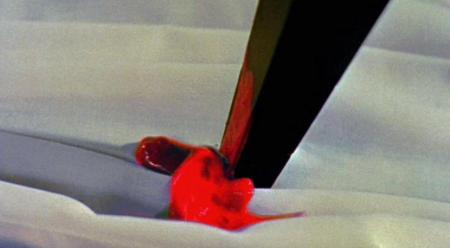
Note the mirror on "Rachel's" dresser in the following scene. The picture might have a low budget, but screenplay writer Pat Fielder, again, knows his vampire lore.

To further explain the above scene is this paragraph from the website: "The Dracathalon":
https://dracathalon.wordpress.com/category/50s/
Dracula quickly takes a fondness for the Mayberry daughter, Rachel. Rachel’s fascination with her foreign cousin leads to quarrels with her boyfriend, who becomes jealous for not receiving as much attention as Cousin Bellac. Dracula begins his indoctrination of Rachel by dropping hints that she should lose the crucifix necklace that she always wears. Here the paranoia of the 50’s begins to creep into the film’s narrative. Dracula, representative of foreign ideals contrary to that of America, must first subvert the Christian underpinnings of Rachel’s worldview. She is reluctant to part with her necklace, as it was “given to her by a friend,” despite Dracula’s insistence that it will “do her no good.”
The climax occurs in the cave "Dracula" has his coffin. "Rachel" and her boyfriend "Tim Hansen", Ray Stricklyn, confront the Count. There is a fight, as in "Blood of Dracula" and the Count falls to his real death.

If my reader remember's Rod Sterling's "Night Gallery". You may remember Francis Lederer once more playing "Dracula" in a World War 2 setting against the Germans. The episode was: "The Devil Is Not Mocked".
Lederer is an interesting person and so was his life. At one point for those familiar with a suburb of Los Angeles called Chatsworth. The actor pretty much owned it, because he went into real estate after he stopped acting. My article entitled "Francis Lederer: the Forgotten Dracula" can be read at:
http://www.bewaretheblog.com/2016/02/francis-lederer-forgotten-dracula-stage.html
In May of 1959 The Curse of the Undead" opened. The film was directed by Edward Dein and written by the director and his wife Margaret. Dein's name may not be known, but among his writing credits was 1943's "The Leopard Man" produced by Val Lewton and directed by Jacques Tourneur. In 1955 the husband and wife team wrote and he directed "Shack Out on 101". This was an excellent Cold War film noir starring Frank Lovejoy and Terry Moore. The picture features Lee Marvin and Keenan Wynn.
What Edward and Margaret came up with for this movie was a vampire tale with a couple of twists. For one the setting was in the old west and for another their vampire could still walk in the daylight, but his eyes were starting to be affected by sunlight and soon only night would be his world.
The plot drops what could be described as the Universal Studio's vampire mythology starting with Todd Browning's 1931 motion picture. copied by MGM and Columbia Pictures and returned too by Hammer films the year before with Christopher Lee. What the Dein's did was go back to actual European folklore in creating "Drago Robles".
The audience will learn that he was one of two brothers who were the sons of a rich Mexican landowner. While away his brother and fiancee fall in love. "Drago" returns to discover this and in rage kills his brother, but the "sin" of doing this deed has effected the young man. He commits a second "sin" by committing suicide. Thus "Drago Robles" becomes a vampire. All within old world tradition and why he can move about in daylight, drink alcohol and interact as if he's a normal person.
Portraying the role of "Drago" and the mysterious gunfighter in black was Michael Pate.

You may recognize this Australian actor's face from John Wayne's 1953 3-D western "Hondo". In it character actor Pate portrayed his first Native American role as Apache chief "Vittorio".

Here the actor is seen with Richard Carlson in another 1953 3'D motion picture "The Maze".

In a small western town there is tension when a typical "B" western villain is running off people's cattle and taking their land. "Buffer" is portrayed by Bruce Gordon. A familiar face to westerns and gangster movies. At the same time that "Curse of the Undead" premiered. Gordon was portraying "Frank Nitti" on television's "The Untouchables".
"Buffer" has cut off the water running onto the land owned by the "Carter Family". To add to their problem the father of "Dolores", Kathleen Crowley, and "Tim", Jimmy Murphy, "Dr. John Carter", John Hoyt, returns home in his buckboard dead. "Dolores'" boyfriend is the town Preacher, "Dan Young", Eric Fleming. Like "Gordon", "Fleming" had just started appearing on television's "Rawhide" with a young "Clint Eastwood". "Dan" notices that the doctor has the same two tiny marks on his neck. That he saw on a young girl both men had seen earlier in the day, before she suddenly died.
Enter "Drake Robey" who knows that both the "Carter" ranch and half of "Buffer's' are part of his father's original Rancho. Both "Dolores" and "Tim" believe "Buffer" is responsible for their father's death. The viewer knows otherwise. "Tim" goes into town and confronts "Buffer".
The town sheriff, Edward Binns, attempts to calm the boy down.
_008.jpg)
This doesn't work and the boy is killed by "Buffer". Who on the sheriff's advise started to leave the saloon, but "Tim's" taunting of him didn't stop. "Dolores" will offer a $100 reward to anyone who kills the murderer, "Buffer", of her father and brother. "Drake Robey" takes her up on the offer. This will lead to a falling out between "Dolores" and "Dan Young" and eventually a romantic tie, of sorts, with :Robey".
Again the vampire traditions are European and "Drake" is actually in love with "Dolores".
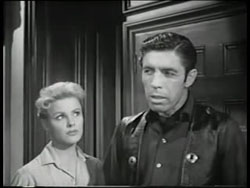
"Dan" and "Drake" have a very interesting meeting of the minds and the Dein's give us a tortured vampire over his deeds.

Inside the chest, "Dan" is leaning upon, is a diary belonging to "Drago's" father. By reading it the history of the vampire is revealed. "Dan" is now faced with convincing "Dolores" and this leads to the two entering the Spanish burial vault that now contains the two coffins of her father and brother.
There "Dan" discovers the original burial place of "Drago" as described in his father's diary and opens it to show "Dolores".
Next he wants to open both "Dolores" father and brothers coffins as he is convinced "Drake" is sharing one of them. She refuses and a a verbal fight occurs with the Preacher leaving the vault to go back to town. As "Dolores" stands there one of the coffins opens and the vampire emerges. The girl faints and "Drago" takes her back to her home. She will remember nothing and be confused as to how she got home.
All of this leads to the climatic gunfight between "Dan" and "Drago", Each time the vampire has been in a gunfight somebody has shot him straight on without anything more than a bullet hole showing. The vampire actually respects the Preacher and for his own real love of "Dolores". Does not want the fight to occur, but only that "Dan" will leave "Dolores" and himself alone.

The Preacher has taken a small wood cross off a button he wears. Note the button on his label. The cross was made out of blessed wood from the Holy Land. "Dan" then placed it on the tip of a bullet and shoots the vampire. "Drago Robles" aka: "Drake Robey" is destroyed and his hold upon "Dolores" ended.

For those of my readers interested in the career of Michael Pate. I wrote an article about the character actor and another Woody Strode. Both who appeared with John Wayne in classic westerns. You will find it at:
http://www.bewaretheblog.com/2015/03/woody-strode-and-michael-pate-one.html
In 1966 as part of a double bill with "Jesse James Meets Frankenstein's Daughter" was another western of terrible quality "Billy the Kid Vs Dracula" featuring 60 year old John Carradine as the vampire count.
"QUEEN OF BLOOD" and "BLACKULA"
Take two parts Soviet Union Science Fiction Films and add one part Executive Producer, without on screen credit, Roger Corman and you have "Queen of Blood" released in March 1966.

Actor Basil Rathbone with second on screen credit, shot his scenes in a day and a half. John Saxon, with the leading role, said his shoot took seven to eight days. Judi Meredith, who in 1962 was the heroine of "Jack the Giant Killer", was the love interest. Not mentioned on the above poster was a friend of director Curtis Harrington, Dennis Hopper. In a 2007 interview Saxton said of Hopper that during the film's shoot he:
was trying very hard to keep a straight face throughoutDirector Harrington had a hard time convincing Roger Corman to hire Czech actress Florence Marly for the Alien Queen. One of Corman's concerns was her age. At the time she was 47. It should be noted Saxon was 31, Meredith 30, Hopper 30 and of course Rathbone at only 74. Florence Marly stole the entire movie and was both beautiful and terrifying at the same time.
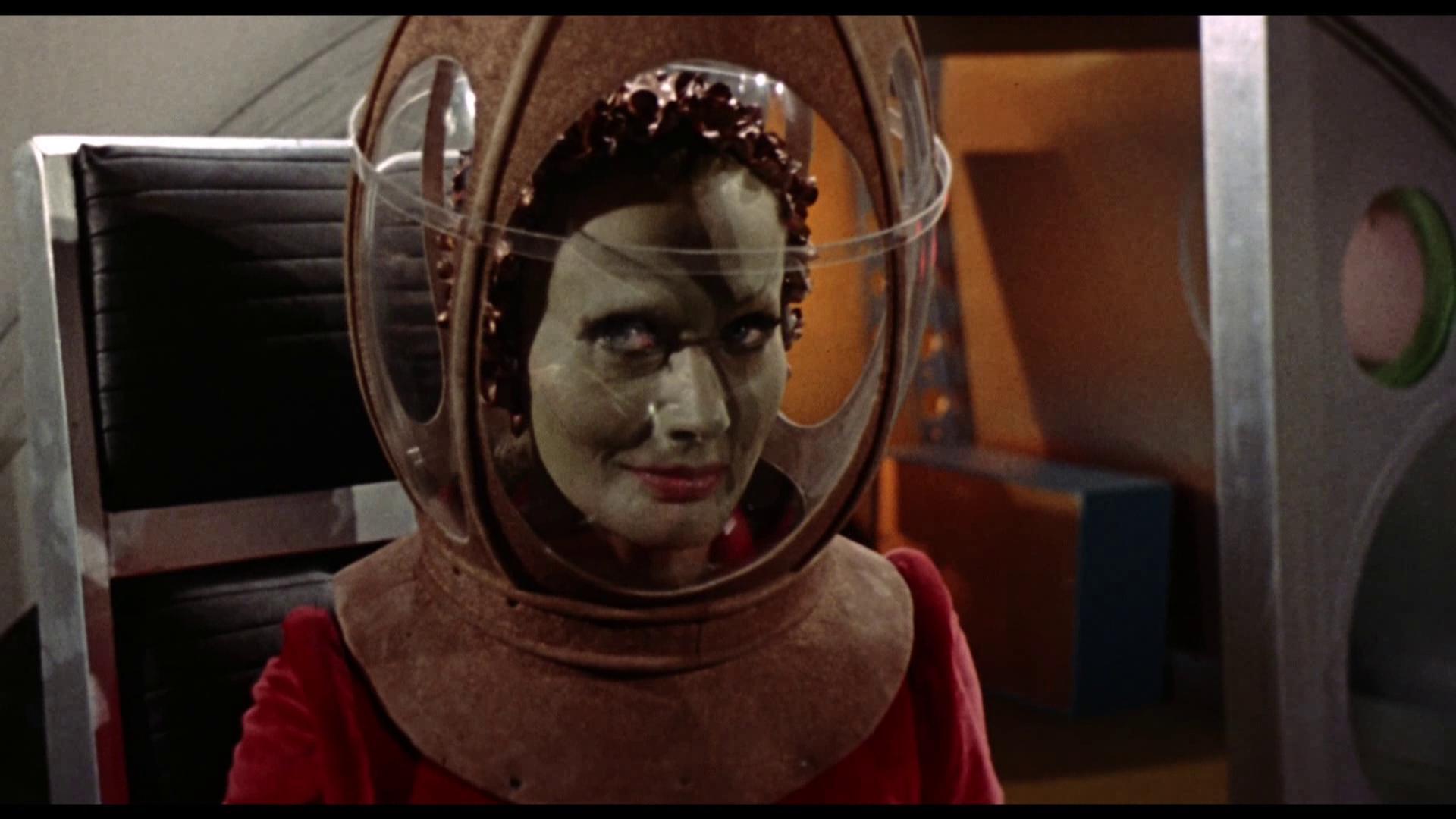
What were the two Soviet motion pictures used for outtakes in "Queen of Blood" about?
The first was 1963's "Mechte Navstrechu (Dream of Meeting)" A rocket from a distant planet crashes on Mars and an Earth rescue mission is sent to meet the Aliens. The Curtis Harrington's screenplay pretty much follows this film with the exception that the female Alien, seen in the first picture below, is friendly. Here are a few scenes:


This film as of this writing can be found on line.
The second motion picture was 1959's "Nebo Zovyot (The Sky Beckons aka The Heavens Beckons)" dubbed into English as 1962's "Battle Beyond the Sun". Once again this is a story about the first space mission to Mars. Here are a few of the original scenes.

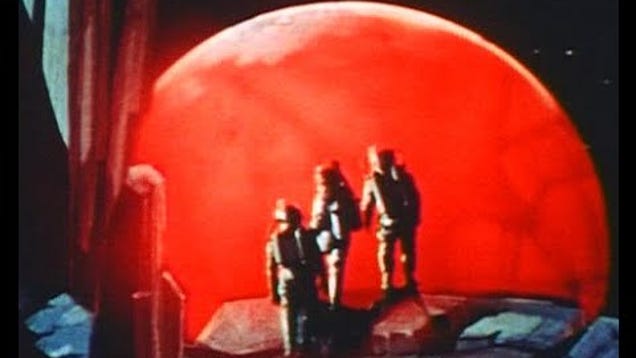
Now for the plot of "Queen of Blood".
The year is 1990 and Space Travel has been well established. At "The International Institute of Space Technology" "Laura James", Meredith, detects a signal coming from deep space. There will be a mission to investigate the signal after "Dr Farrady", Rathbone, translates it and determines its from an Alien Race.
We now have two motion pictures 1965's "Planet of the Vampires" and this 1966 feature using the same plot device Ridley Scott used 13 years later for "Alien", All three pictures with similar results to the crews answering the distress call.
The space ship "Oceano" was sent with a three person crew to Mars to find the source of the Alien signal. The crew consists of "Paul Grant", Hopper, "Anders Brockman", Robert Boon, and "Laura". The craft was damaged by a sunburst. They land on Mars to discover the downed alien craft with only one dead body on board. Faraday decides that the rest of the crew may have been rescued and moved to another location. He orders a second mission to attempt to locate the alien rescue ship.
The ship sent form Earth to go search the moons of Mars is crewed by "Laura"s" fiance "Allan Brenner", Saxton, and "Tony Barrata", Don Either. The two arrive on Phobos on the space craft "Meteor". There they find an alien escape pod with a still breathing female inside. The two\rescue her and then dock with the "Oceano". Transferring all three on board the larger craft.

Compare Dennis Hopper's spacesuit to the one's from "Mechte Navstrechu". Part of the matching of the two movies.
The alien is unconscious since fist being discovered. When she regains consciousness the alien women miles at the three men, but for some reason not a "Laura". The "Oceano" is now heading back to Earth.


During the night the alien attacks and kills "Paul" who was guarding her. This happens after the alien female hypnotizes the astronaut.
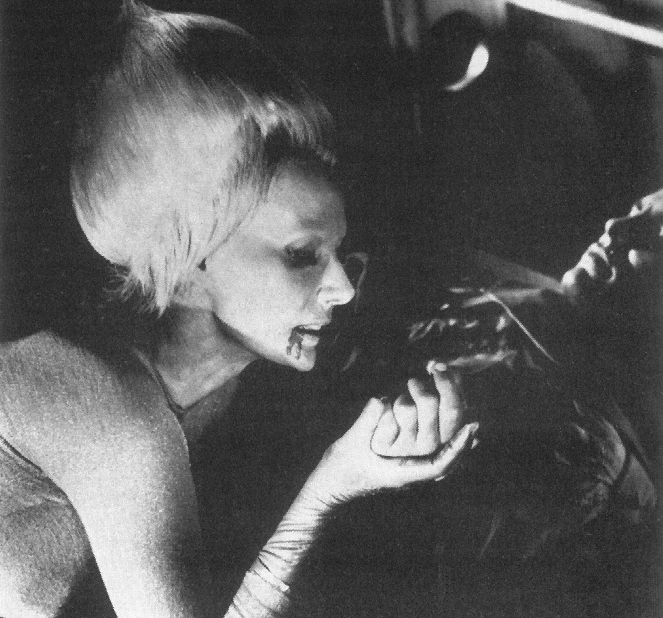
The other astronauts make the assumption the alien survives on blood and decide to keep her alive. So they feed her plasma from the "Oceano's" medical supplies. When this runs out the alien kills "Anders". She now make an attempt to kill "Allan", but "Laura" stops her and slightly scratches her face. In shock the two humans watch the female scream as if in horrible pain and then bleed to death. Her skin is very thin and she was apparently anemic.
Before the "Oceano" lands on Earth. "Laura" and "Allan' discover alien eggs laid by the "Queen of Blood". When the ship returns the eggs are removed and in a cameo appearance the co-creator of "Famous Monsters of Filmland" Forest J. Ackerman is seen carrying them.
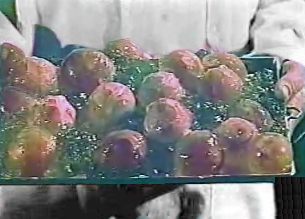
In the 1970's there was a movie trend called either "Blaxploitation", or "Blacksporitation". Black film makers started creating film for the black audience. However, many of these motion pictures such as "Shaft", "Cleopatra Jones" and "Foxy Brown" crossed over to white audiences to the black film makers surprise. Besides seeming remakes of old gangster films such as 1931's "Little Caesar" that made Edward G. Robinson a star, becoming 1973's "Black Caesar". There were horror movies that were Black remakes of classic movies.
"Frankenstein" became "Blackenstein". "Dr. Jekyll and Mr Hyde" became "Dr. Black and Mr. Hype" starring Bernie Casey. Then there was "BLACKULA" released August 25, 1972.
.

The basic plot has an 18th Century African Prince "Mamuwalde", William Marshall, and his wife "Luva:, Vonetta McGee, visiting Castle Dracula to ask the Count to help suppress the slave trade. Something happens and "Dracula" turns the Prince into a vampire and seals him in a coffin. He then imprisons "Luva" who will die in a cell within the castle.

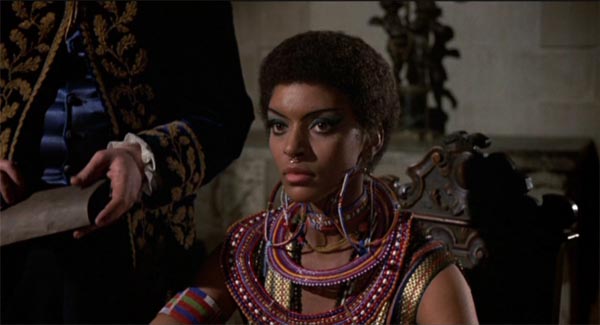
Switch to 1972 Los Angeles and the arrival of the coffin to be used by two interior decorators "Bobby" and "Billy". Who of course make the mistake of opening it and releasing "Blackula", becoming his first victims.
At the funeral of "Bobby". "Blackula" spots "Tina Williams", also Vonetta McGee, who of course looks like the reincarnation of his lost wife. People will die by the vampire as he seeks "Tina".
As with Francis Lederer in "The Return of Dracula". It is the performance of William Marshall that makes this recycled story line work so well. Marshall was a Shakespearean trained actor whose performance of "Othello" is still considered one of the finest on stage. I met the actor once while working at a small Post Office in North Hollywood. When he came in to buy some stamps. I confirmed the man in front of me was William Marshall and mentioned his "Othello". That surprised the actor as everyone knew him for "Blackula" and it's sequel. Shortly after this meeting many television viewers of "Pee-wee's Playhouse" would know the actor as the "King of Cartoons". My article on Marshall can be found at:
http://www.bewaretheblog.com/2015/01/william-marshall-shakespeares-vampire.html
Returning to the feature:
"Mamuwalde: is able to lure the reincarnation of his love "Tina Williams" to his hiding place, but police arrive and a shoot out takes place. "Tina" is fatally shot and to save her "Mamuwalde" turns her into a vampire. He places her into his own coffin and "Tina" is killed by "Police Lieutenant Peters", Gordon Pinsent, who thinks "Blacula" was in the coffin.
Once again his love has been taken from him and "Mamuwalde" goes to the roof of a building and dies in the sunlight.
The sequel was appropriately entitled "Scream, Blackula, Scream" released on June 27, 1973.

Pam Grier portrays a Voodoo Priestess apprentice in this feature.

The vampire is brought back to life by the son of the Priestess training Grier's "Lisa Fortier". He has taken the bones of the dead "Mamualde" and through Voodoo brought him back to life, but also through Voodoo enslaved him. In the end using the Voodoo Doll of the African Prince. "Lisa" will destroy "Blackula" forever bringing "Mamuwalde" peace at last.
"DANCE OF THE VAMPIRES" and "DAUGHTERS OF DARKNESS"
The title on the screenplay by French screenplay writer Gerard Brach and Roman Polanski read "Dance of the Vampires". When the motion picture premiered in the UK in February 1967 that title appeared on screen. However, the United States was a different matter and the feature on opening day November 13, 1967 had one of the longest and funniest titles ever. Polanski's "Dance of the Vampires" was now "The Fearless Vampire Killers, or Pardon Me, Your Teeth Are in My Neck".
Depending of what country the movie played in that title was changed slightly, but the poster reflects the scene were the vampire count bites the inn keeper's daughter in the bath.

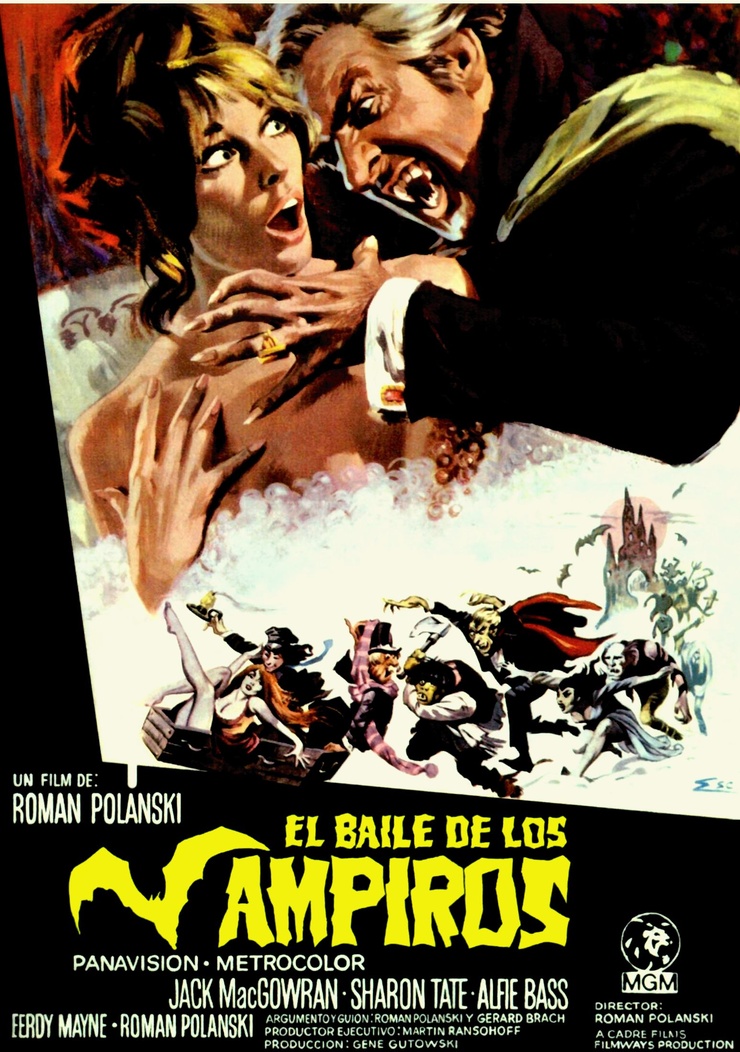
That screenplay today would not be made as it attacks every known stereo type of the time. For instance the main vampire's son is Gay and presented in the stereo typical imagination by straights of a gay man.
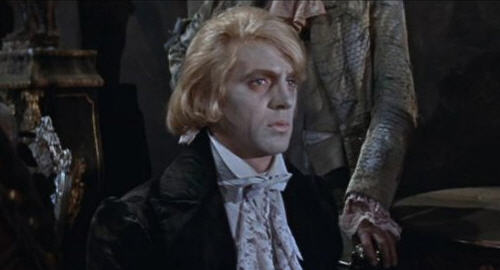
There is a very funny scene with a Jewish vampire. A women holds up a crucifix and he replies in a strong stereo typical Jewish accent:
I'm not that kind of a vampire.

The plot has the very inapt "Professor Abronsius", Jack MacGrowan, and his even more inapt assistant "Alfred", Polanski himself, going after the most notorious vampire of all "Count von Krolock", the excellent German actor Ferdy Mayne and his minions.

"Alfred" falls in love with the daughter of Inn Keeper, "Yoine Shagal", Alfie Bass, who will become the Jewish vampire I mentioned, The daughter is named "Sarah" and in one funny scene "Alfred" walks in on her in the bath. After "Alfred" leaves, as I mentioned above, "Count Krolock" enters and bites the girl on the neck.

"Sarah" is kidnapped by the Count and taken to his castle. Alfred" is determined to rescue "Sarah" from the vampire count. This will lead both "Fearless (?)" vampire killers into the Count's castle and witness the dance of the vampires of the original title.


The rescue will be accomplished, but unknown to both "Alfred" and the Professor is that "Sarah" has become a vampire. She bites "Alfred" on the neck as "Professor Abronisus" drives their sled away from the castle content in the knowledge he has stopped the Count from spreading vampirism.
The movie is hilarious.
My reader will have noticed I did not mention the actress who was portraying "Sarah". It was on the shoot for this film that Roman Polanski fell in love with Sharon Tate and her with him. The two would be married and two years later the pregnant actress would be murdered by Charles Manson and his Cult on August 8, 1969. The "Tate-Labianca Murders" were called the Crime of the Century and was the real horror story.
My article has now come full circle. When upon May 28, 1971 audiences viewed the premier of a motion picture made in Belgium, directed by that country's Harry Kumel, but filmed in the English language. This Belgium/French and West German production was "Le Rouge aux levres (The Red Lips)", but released in the United States as "Daughters of Darkness".
It is known by fans of Bram Stoker's novel that he used the real life Vlad III aka: Vlad Tepes aka: Vlad the Impaler. Also known as "Vlad Dracul (Vlad Dracula) for his vampire model. Vlad was the Vivolde (Prince) of Wallachia from 1448 until his death in 1477.
Move 83 years later to 1560 were a women was born who may have been Joseph Sheridan Le Fanu's inspiration for "Carmilla". Her name was Elizabeth Bathory and her family owned land in Wallachia and Transylvania. Among other property.

The "Guinness World Record Book" list Elizabeth as the most prolific of female serial killers. The official record from her trial listed 80 murders, but the number, depending on the witnesses presented, range from 100 to 650. The body count dug up numbered approximately 200, but she had accomplices and therefore the court would only directly connect her with the official 80 murders.
According to legend Elizabeth Bathory bathed in the blood of virgin girls to keep her youth and beauty. As the years passed and her legend grew. Elizabeth became a vampire, because of course she lived in Transylvania.

Portraying "Elizabeth Bathory" was French actress Delphine Seyrig. She was Internationally known for such classic French motion pictures as Alain Resnais' 1961's "L'Annee demiere a Marienbad (Last Year at Marienbad)" and Francois Truffaut's 1968 "Baisers voles (Stolen Kisses)".
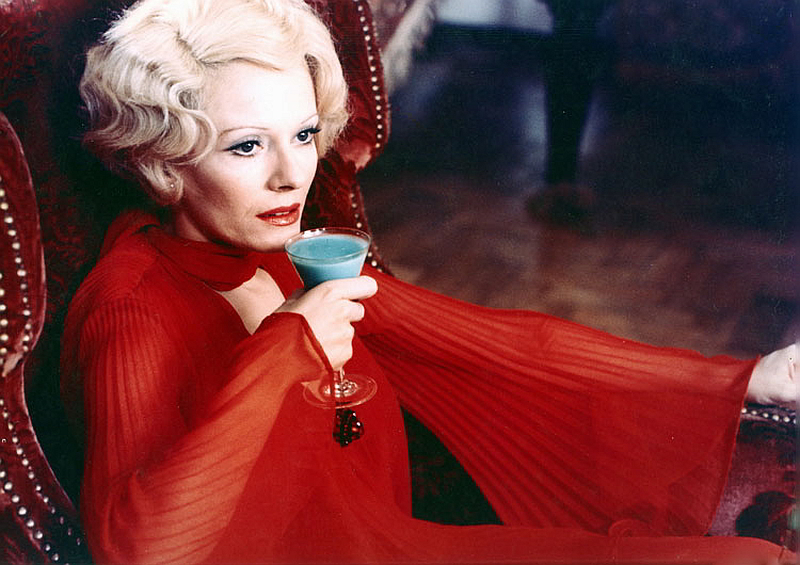
In 1990 Camille Paglia, Professor of Arts, at the University of Arts in Philadelphia, Pennsylvania wrote of "Daughter of Darkness:
This movie at the time was not for the faint of heart and was obviously very artful and unusual for a vampire film then, or now,
As is implied by O'Brien newlyweds "Stefan", John Karlen, and his wife "Valerie", Danielle Ouimet, are on their honeymoon and check into an old style "Grand Hotel" located on the "Ostend". A part of a Belgian coastal city in West Flanders. The setting is 1971.
Adding to the setting is the fact it is off season. Therefore, the entire hotel is vacant except for the young couple.
THEN THE SUN SETS!
A mysterious Hungarian Countess named Elizabeth Bathory arrives with her female secretary "Ilona", Andrea Rau.
.
The Hotel Clerk, Paul Esser, swears to the young couple that he saw the "Countess" when he was a young boy at the hotel. The newly arrived pair may be connected to a series of three murders that happened the previous week.
On a day trip "Stefan" and "Valerie" witness the results of a fourth murder. That evening the "Countess" begins to take a definite interested in the young couple. It seems to become an obsession for this mysterious personage and "Stefan" and "Valerie" find themselves lured into a seductive quartet with the "Countess" and "Ilona".


This interaction will lead to sadism, the murder of both "Ilona" and "Stefan". Then eventually "Elizabeth Batholy" herself after she has turned "Valerie" into a vampire. The film ends with the elegant "Valerie" now stalking new victims of her own.
I hope my readers made it back to their coffins before night ended and they will look up some of these "Not the same old Vampire movies".

"Sarah" is kidnapped by the Count and taken to his castle. Alfred" is determined to rescue "Sarah" from the vampire count. This will lead both "Fearless (?)" vampire killers into the Count's castle and witness the dance of the vampires of the original title.


The rescue will be accomplished, but unknown to both "Alfred" and the Professor is that "Sarah" has become a vampire. She bites "Alfred" on the neck as "Professor Abronisus" drives their sled away from the castle content in the knowledge he has stopped the Count from spreading vampirism.
The movie is hilarious.
My reader will have noticed I did not mention the actress who was portraying "Sarah". It was on the shoot for this film that Roman Polanski fell in love with Sharon Tate and her with him. The two would be married and two years later the pregnant actress would be murdered by Charles Manson and his Cult on August 8, 1969. The "Tate-Labianca Murders" were called the Crime of the Century and was the real horror story.
My article has now come full circle. When upon May 28, 1971 audiences viewed the premier of a motion picture made in Belgium, directed by that country's Harry Kumel, but filmed in the English language. This Belgium/French and West German production was "Le Rouge aux levres (The Red Lips)", but released in the United States as "Daughters of Darkness".
It is known by fans of Bram Stoker's novel that he used the real life Vlad III aka: Vlad Tepes aka: Vlad the Impaler. Also known as "Vlad Dracul (Vlad Dracula) for his vampire model. Vlad was the Vivolde (Prince) of Wallachia from 1448 until his death in 1477.
Move 83 years later to 1560 were a women was born who may have been Joseph Sheridan Le Fanu's inspiration for "Carmilla". Her name was Elizabeth Bathory and her family owned land in Wallachia and Transylvania. Among other property.

The "Guinness World Record Book" list Elizabeth as the most prolific of female serial killers. The official record from her trial listed 80 murders, but the number, depending on the witnesses presented, range from 100 to 650. The body count dug up numbered approximately 200, but she had accomplices and therefore the court would only directly connect her with the official 80 murders.
According to legend Elizabeth Bathory bathed in the blood of virgin girls to keep her youth and beauty. As the years passed and her legend grew. Elizabeth became a vampire, because of course she lived in Transylvania.

Portraying "Elizabeth Bathory" was French actress Delphine Seyrig. She was Internationally known for such classic French motion pictures as Alain Resnais' 1961's "L'Annee demiere a Marienbad (Last Year at Marienbad)" and Francois Truffaut's 1968 "Baisers voles (Stolen Kisses)".

In 1990 Camille Paglia, Professor of Arts, at the University of Arts in Philadelphia, Pennsylvania wrote of "Daughter of Darkness:
A classy genre of vampire film follows a style I call psychological high Gothic. It begins in Coleridge's medieval Christabel and its descendants, Poe's Ligeia and James's The Turn of the Screw. A good example is Daughters of Darkness, starring Delphine Seyrig as an elegant lesbian vampire. High gothic is abstract and ceremonious. Evil has become world-weary, hierarchical glamour. There is no bestiality. The theme is eroticized western power, the burden of history.While critic Geoffrey O'Brien three years later in a review within the "New York Book of Reviews", April 22, 1993 described the motion picture:
This movie at the time was not for the faint of heart and was obviously very artful and unusual for a vampire film then, or now,
As is implied by O'Brien newlyweds "Stefan", John Karlen, and his wife "Valerie", Danielle Ouimet, are on their honeymoon and check into an old style "Grand Hotel" located on the "Ostend". A part of a Belgian coastal city in West Flanders. The setting is 1971.
Adding to the setting is the fact it is off season. Therefore, the entire hotel is vacant except for the young couple.
THEN THE SUN SETS!
A mysterious Hungarian Countess named Elizabeth Bathory arrives with her female secretary "Ilona", Andrea Rau.
.

The Hotel Clerk, Paul Esser, swears to the young couple that he saw the "Countess" when he was a young boy at the hotel. The newly arrived pair may be connected to a series of three murders that happened the previous week.
On a day trip "Stefan" and "Valerie" witness the results of a fourth murder. That evening the "Countess" begins to take a definite interested in the young couple. It seems to become an obsession for this mysterious personage and "Stefan" and "Valerie" find themselves lured into a seductive quartet with the "Countess" and "Ilona".


This interaction will lead to sadism, the murder of both "Ilona" and "Stefan". Then eventually "Elizabeth Batholy" herself after she has turned "Valerie" into a vampire. The film ends with the elegant "Valerie" now stalking new victims of her own.
I hope my readers made it back to their coffins before night ended and they will look up some of these "Not the same old Vampire movies".





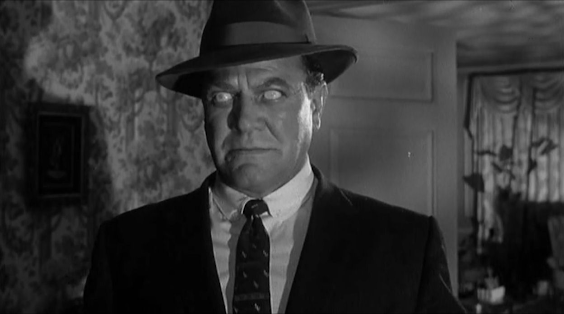







No comments:
Post a Comment